Neuromuscular Applications
Neuromuscular disorders are defined by impaired proprioception. This crucial function involves the perception of balance, joint angle, movement, muscle length, and position. These disorders disrupt sensory information from muscle length and tendon force receptors.
Listen to a mini-lecture on Neuromuscular Disorders © BioSource Software LLC.
SEMG biofeedback has been used in stroke, incomplete spinal cord lesion, cerebral palsy, lower motor neuron lesion, and peripheral nerve problems, Many physical therapy and occupational therapy clinics do not use this modality due to limited practitioner knowledge and failure to satisfy the minimum conditions for treatment success (Bolek, 2020).
However, a majority of RCTs evaluating the efficacy of SEMG biofeedback for cerebral palsy and cerebrovascular accident have shown encouraging improvements in function and support a revised rating of level 4 - efficacious. Graphic © CGN089/Shutterstock.com.
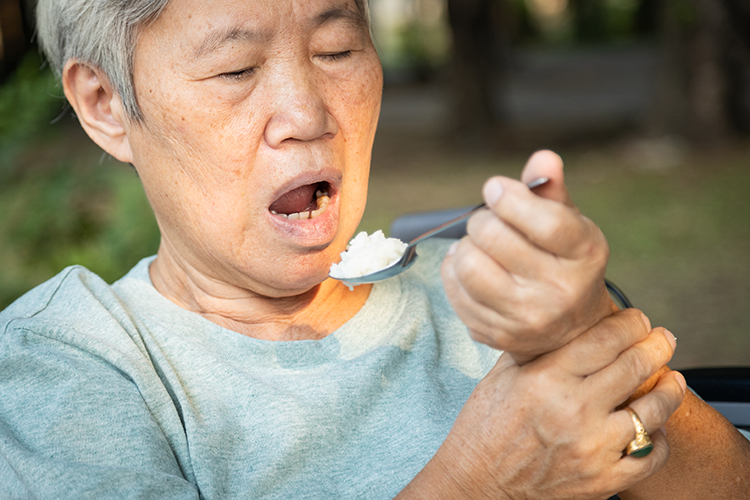
There is a convergence among the approaches of Wolf, Bolek, and Taub that promises to increase the effectiveness of biofeedback for rehabilitation. First, teach patients to solve problems in achieving functional movement. Wolf employs a Socratic approach that emphasizes patient creativity in reacquiring functional movement.
Second, train ensembles of muscles to perform everyday movements. Bolek's quantitative surface electromyography (QSEMG) is an innovative strategy for teaching functional movement patterns by providing feedback from multiple muscle sites. Bolek (2016) argues that restoring motor control does not automatically improve functional movement. Clinicians have to train patients to perform self-care tasks.
Third, prevent learned disuse by providing extensive practice with the affected limb. Taub's Constraint-Induced Movement Therapy (CIMT) is a revolutionary approach to treating stroke and other disorders, combining physical therapy, behavioral principles, and biofeedback to overcome learned non-use of an affected limb.
Rehabilitation professionals can use diverse biofeedback modalities to treat neuromuscular disorders. These include electromyography, force feedback, joint angle feedback, real-time ultrasound imaging (RTUS), velocity feedback, and camera-based systems. Graphic © starphotograf/iStockphoto.com.
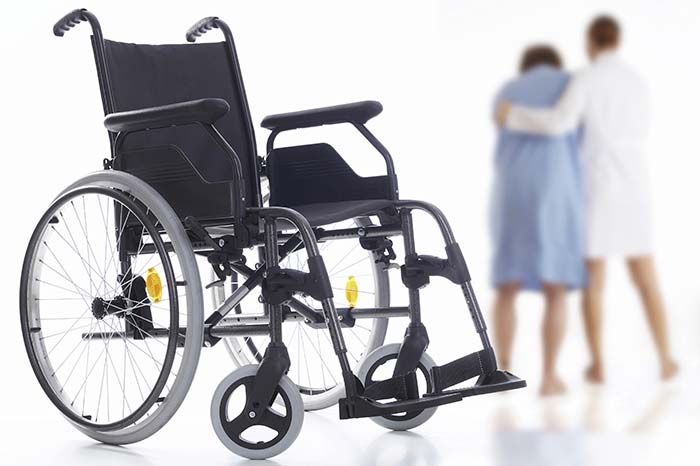
BCIA Blueprint Coverage
This unit discusses the Central nervous system (IV-B), General treatment considerations (IV-D), and Target muscles, typical electrode placements, and SEMG treatment protocols for specific neuromuscular conditions (IV-E).
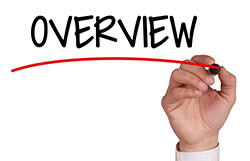
This unit covers Motor Control Systems, Stroke, Spinal Cord Injury, Cerebral Palsy, Multiple Sclerosis, Peripheral Nerve Injury, and Torticollis.
Please click on the podcast icon below to hear a full-length lecture.

EVIDENCE-BASED PRACTICE (4TH ED.)
We have updated the efficacy ratings for clinical applications covered in AAPB's Evidence-Based Practice in Biofeedback and Neurofeedback (4th ed.).
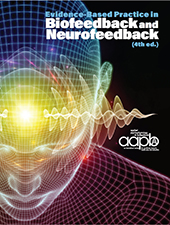
Motor Control Systems
The prefrontal cortex controls attention and planning. Most complex behaviors are planned in the prefrontal cortex. The frontal lobes develop strategies for variouse contingencies, monitor events, predict outcomes, and switch to new strategies as needed.
The supplementary motor area programs movements into sequences during learning. The premotor cortex adjusts existing motor programs under the guidance of external sensory information.
Cortical motor and premotor areas appear to map behaviors instead of specific movements (Breedlove & Watson, 2020; Graziano & Aflalo, 2007).
The primary motor cortex executes motor programs through two descending tracts.

The lateral group (corticospinal tract, corticobulbar tract, and rubrospinal tract) and the ventromedial group (vestibulospinal tract, tectospinal tract, reticulospinal tract, and ventral corticospinal tract).
The corticospinal tract provides discrete control of fingers, hands, arms, trunk, and upper legs. The axons of upper motor neurons descend from the primary motor cortex to the medulla, where most fibers cross to the opposite side (lateral corticospinal tract), and a minority descends on the same side (ventral corticospinal tract).
These neurons synapse (directly or via interneurons) on lower motor neurons in the ventral gray matter of the spinal cord. The connections are one-sided (lateral tract) or two-sided (ventral tract). The two-sided connection provides the basis for rehabilitation using Wolf's motor copy procedure described in the next section.
The lateral and ventral tracts activate central pattern generators in the spinal cord that direct the recruitment of motor units to perform repetitive movements.
STROKE
Cerebrovascular accident (CVA) or stroke involves the destruction of brain tissue (upper motor neurons) due to disorders of blood vessels that supply the brain.
Listen to a mini-lecture on Cerebrovascular Accident © BioSource Software LLC.
Since higher motor systems strongly inhibit lower systems, stroke disruption of this control can result in flexor (and sometimes, extensor) hypertonicity and spasticity (Bolek, Rosenthal, & Sherman, 2016). Graphic © David Marchal/Shutterstock.com.

CVAs show abrupt onset and involve temporary or permanent neurological symptoms like aphasia, paralysis, or loss of sensation.

CVAs are produced by a cerebral hemorrhage and cerebral ischemia.
Listen to a mini-lecture on Hemorrhagic and Ischemic Strokes © BioSource Software LLC.

Check out informative YouTube videos, Stroke, by Nucleus Medical Media, and 3D Medical Animation (HD) - Stroke Management.
Cerebral hemorrhage involves the rupture of a cerebral blood vessel, often due to bursting aneurysms (ballooning of blood vessel walls), that release blood that damages adjacent neural tissue. A subarachnoid hemorrhage releases blood into the subarachnoid space between the middle meninx (membrane) and the brain. An intracerebral hemorrhage releases blood into the brain. Cerebral hemorrhage accounts for 15% of strokes and is fatal in up to 50% of patients.
Cerebral ischemia disrupts blood circulation to a brain region and accounts for 85% of strokes. The three leading causes of cerebral ischemia are arteriosclerosis, thrombosis, and embolism.
Arteriosclerosis is a narrowing of cerebral blood vessels, often due to lipid buildup, resulting in total blockage.
Thrombosis involves forming a plug called a thrombus, which can be comprised of air bubbles, blood clots, fat, oil, or tumor cells (or their combination), that blocks circulation where it forms. An embolism is a thrombus that moves downstream (from a larger to a smaller blood vessel), where it becomes stuck and causes almost three of every four ischemic strokes. Graphic © Elen Bushe/Shutterstock.com.
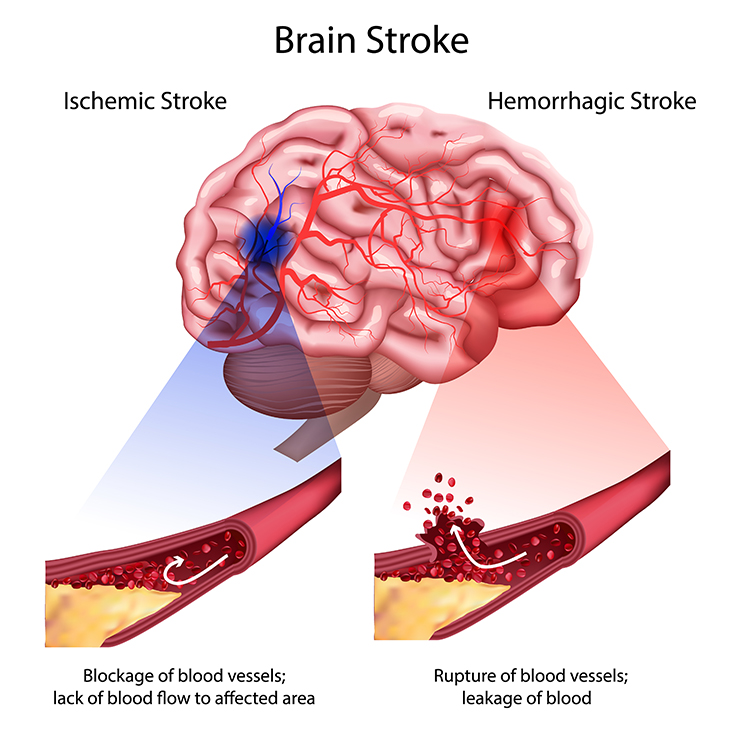
Most of the damage inflicted by cerebral ischemia does not occur immediately but develops over 1-2 days. The mechanisms of ischemia-induced injury may vary across brain structures. Regions like the hippocampus are more vulnerable than others. Most neuron loss may be due to excessive release of excitatory amino acids, especially glutamate. Glutamate release may produce lethal swelling in neurons due to the entry of ions and water. Glutamate also increases calcium entry into neurons and may raise the levels of enzymes that produce apoptosis, which is cell death (Breedlove & Watson, 2020). Glutamate may also be responsible for ischemic damage to oligodendrocytes (CNS glial cells that myelinate axons) via overactivation of NMDA receptors (Salter & Fern, 2005).
Time is Brain
Diagnosis and treatment within the first hour are crucial for saving at-risk brain tissue.Listen to a mini-lecture on Time is Brain © BioSource Software LLC. Graphic © iLoveCoffeeDesign/Shutterstock.com.
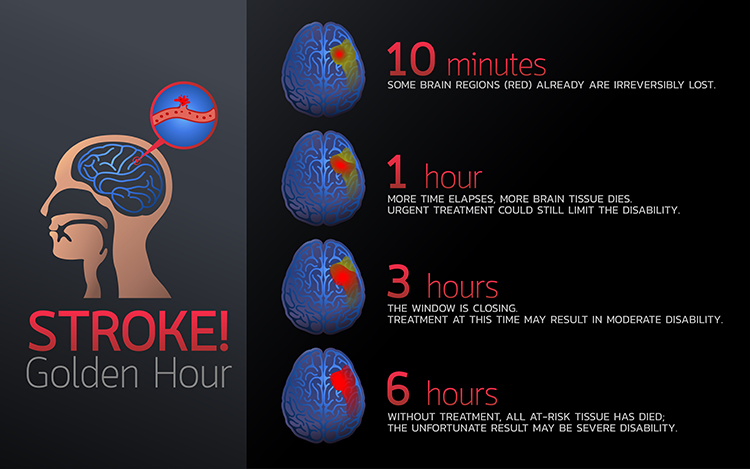
Stroke Symptoms
The presence of weakness, speech difficulty, visual changes, facial droop, numbness/tingling, or dizziness can signal a stroke.Listen to a mini-lecture on Stroke Symptoms © BioSource Software LLC. Graphic © ah_designs/Shutterstock.com.
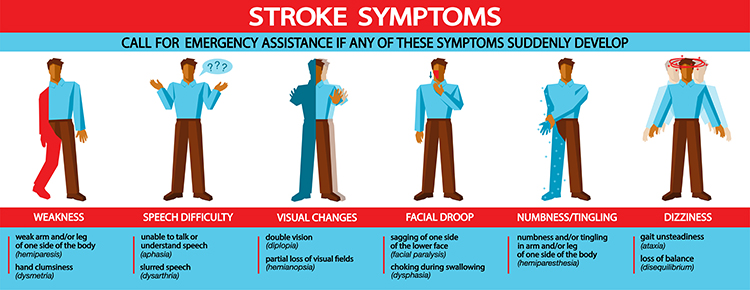
Demographics
CVA is the most common brain disorder, affecting 795,000 Americans each year. The majority, 610,000, are initial attacks. In the United States, 87% of strokes are ischemic, and 13% are hemorrhagic (Liebeskind, 2014).Overview
CVAs can damage the pyramidal and extrapyramidal systems, resulting in symptoms like paralysis and limb weakness. Wolf speculates that disruption of proprioception is responsible for the loss of motor control.
Pyramidal System Damage
The pyramidal motor system starts in the primary motor cortex and projects to spinal cord motor neurons. Fibers from the primary motor cortex cross over to the opposite side in structures on the ventral medulla shaped like pyramids. Damage to any part of the pyramidal system will affect movement, especially fine motor control.Damage to any part of the corticospinal tract results in transient flaccid paralysis, which is a complete loss of muscle tone. This occurs immediately after injury to the pyramidal motor system. Transient flaccid paralysis usually lasts for only a few days or weeks. It is gradually replaced by a more permanent state of hyperreflexia, in which reflexes are highly reactive and exaggerated. Hyperreflexia can produce spastic paralysis.
Damage to areas of the parietal and prefrontal cortex in the left hemisphere that relay information to the primary motor cortex about the sequence of movements to be performed can produce apraxia. In apraxia, a person cannot organize movements into a productive sequence and can no longer perform previously familiar hand movements (Wilson, 2003).
Extrapyramidal System Damage
The extrapyramidal motor system arises from neurons in the cerebral cortex, basal ganglia, cerebellum, and reticular formation. The extrapyramidal motor system controls bilateral, gross movements (lifting an object) and postural changes.Damage to the extrapyramidal system causes hyperreflexia, which leads to spasticity. Spasticity involves elevated muscle tone with resistance to stretching and interferes with the normal smooth movement of the limbs. As the injured person attempts to move a limb, stretch reflexes in antagonist muscles are called into action. The limb moves in a jerky fashion (clonus) until rigidity sets in, halting movement altogether (Wilson, 2003).
Limb Weakness
Musculoskeletal weakness is a common symptom and can be produced by diverse causes, including:- brain tumor
- stroke
- spinal cord damage
- amyotrophic lateral sclerosis (progressive loss of muscle bulk and strength, with intact sensation)
- diabetes (weakness or paralysis and loss of sensation in areas served by damaged nerves)
- Guillain-Barre Syndrome (same as above)
- myasthenia gravis (paralysis or weakness of several muscles)
- Duchenne’s disease (progressive widespread muscle weakness)
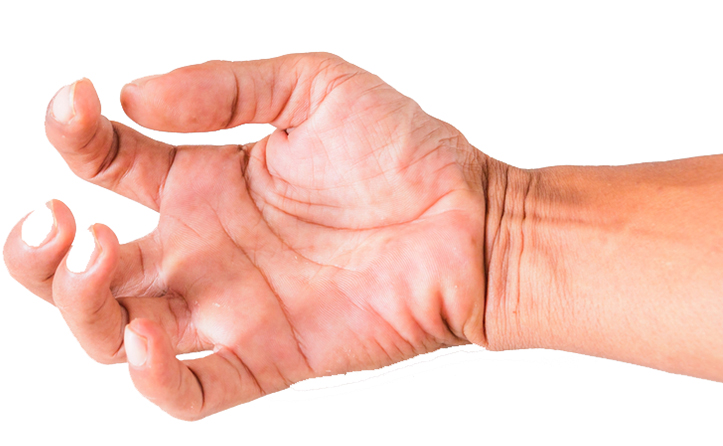
The availability of intact motor units can be confirmed by inserting percutaneous electrodes in a muscle and instructing the patient to perform voluntary movements. These electrodes may be required because muscle output is weak, the muscle lies deep beneath the skin, adjacent muscles contaminate the EMG signal, or the EMG signal is absorbed by subcutaneous fat.
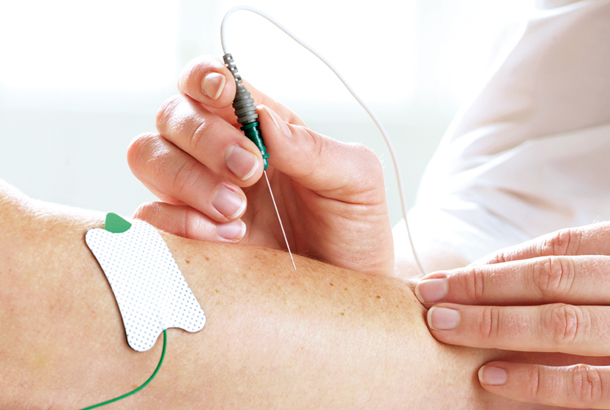
Physical therapy should be started as soon as the patient is stable, as early as two days post-stroke. While some patients will experience the fastest recovery in the first few days, many will improve for six months or longer. EMG biofeedback is incorporated in physical therapy exercises to reduce spasticity, strengthen paretic muscles, and restore functional movement.
Neuromuscular disorders should be treated within the context of physical therapy. A rehabilitative medicine specialist should evaluate the patient and design the treatment plan. Biofeedback should be integrated in assessment and rehabilitative exercises because it can provide real-time information for the clinician and patient.
Cause of Loss of Motor Control
Research by Wolf has shown that impaired proprioception may be central to loss of motor control following a CVA. If a CVA impairs a patient's ability to understand, follow, and remember instructions, this will prevent successful biofeedback training. For this reason, neurologists must evaluate a patient's cognitive performance before starting biofeedback-assisted physical therapy.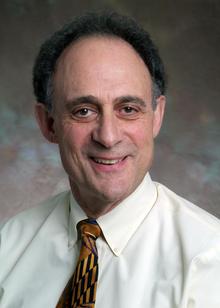
Wolf (2011) champions a problem-solving approach, instead of repetition, to teach patients to reacquire movement. He emphasizes learning to use an impaired extremity in functional activity instead of simple down-training and up-training individual muscles. When patients cannot perform an activity, Wolf challenges them to explore new muscle recruitment patternsto overcome this challenge. Like Bolek's quantitative surface electromyography (QSEMG) approach, Wolf simultaneously trains multiple muscles simultaneously. Like Taub, he incorporates Constraint-Induced Movement Therapy (CIMT), in which he restricts clients to only use the unaffected limb 5 hours a day for 10 weeks.
Listen to a mini-lecture on Wolf's Socratic Approach © BioSource Software LLC.
Muscle Testing
The availability of intact motor units can be confirmed by inserting percutaneous electrodes in a muscle and instructing the patient to perform voluntary movements.These electrodes may be required because muscle output is weak, the muscle lies deep beneath the skin, adjacent muscles contaminate the EMG signal, or the EMG signal is absorbed by subcutaneous fat.
CVA Prognosis
Around 22% to 25% of stroke patients die within a year of their first stroke. About 90% of these survivors will suffer mild to catastrophic long-term disabilities in their movement, sensation, memory, or cognition (Newsweek, March 8, 2004).CVA Problems
A study of patients 65 years and older found the following results six months after their strokes (Newsweek, March 8, 2004):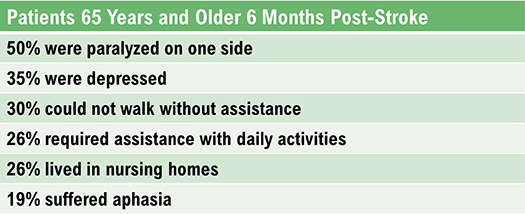
Physical Therapy
Physical rehabilitation procedures include diathermy, heat packs, or hot tubs to reduce spasticity; muscle relaxants like Flexeril to reduce spasticity; evaluation of range of motion and exercises to increase range of motion; immobilizing the unaffected limbs; and strength training.Constraint-Induced Movement Therapy
Constraint-Induced Movement Therapy (CIMT) represents a revolutionary paradigm shift that produces significant gains in limb use following a cerebrovascular accident.Listen to a mini-lecture on Taub's Constraint-Induced Movement Therapy © BioSource Software LLC.
The rationale for CIMT is that a patient following a CVA or injury experiences "learned non-use," which contributes to loss of limb function. When a patient's efforts to use the affected limb result in failure, this reinforces its non-use and reliance on the healthy limb. These behavioral changes result in cortical reorganization that ensures the continued non-use of the affected limb.

CIMT limits movement of the unaffected limb by placing it in a sling or mitt for 90% of waking hours for 2-3 weeks.
Taub's team constrains the healthy limb to force the patient to rely on the affected one and uses operant procedures to restore functional use of the affected limb.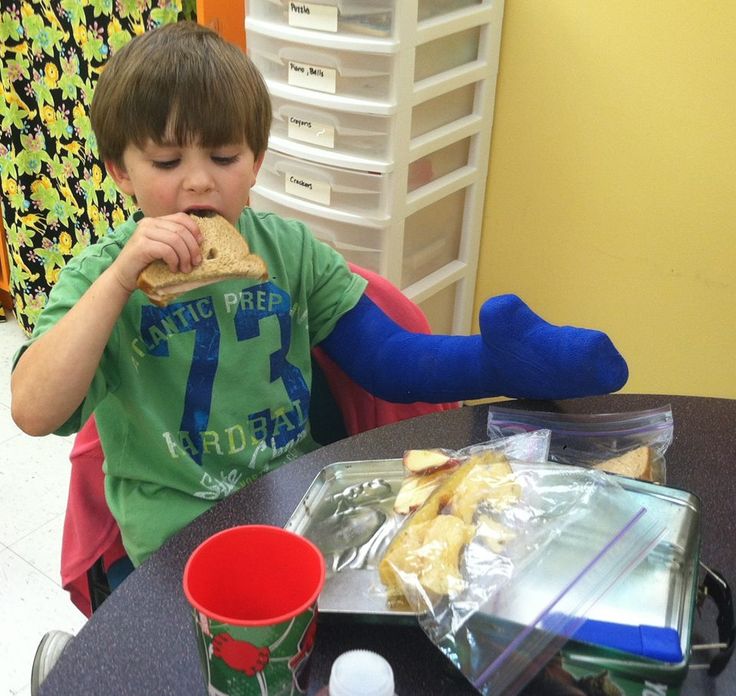
The most important operant principle used in CIMT is shaping, where therapists reinforce successive approximations of the target behavior (marauding). They intensively train patients to use the more-affected limb many hours daily (massed practice) using biofeedback as an adjunctive procedure.
Therapists provide patients with continuous auditory and visual feedback, including verbal reports and "shaping data forms" which graphically summarize their progress. In CIMT for lower limbs, limb load monitors and goniometers can provide immediate and continuous feedback about gait (Shaffer & Moss, 2006).
Taub (2005) described the use of biofeedback in CIMT: "The limb load monitor provides continuous feedback of the force and timing of each footfall. We use it to correct stance time on the more affected leg, increase weight supported by it and increase the cadence of gait. The electric goniometer gives either continuous or error feedback of knee joint angle."
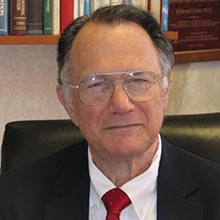
Neuroimaging and transcranial magnetic stimulation studies show that CIMT increases the cortical area controlling the more affected limb through use-dependent cortical reorganization.
CIMT has been effectively used to treat the upper limb of CVA and chronic traumatic brain injury patients and the lower limb of CVA, incomplete spinal cord injury, and hip fracture patients. CIMT has also been applied to treat musician focal hand dystonia and phantom limb pain. Jadali (2021) observes that current practice modifies CIMT using bimanual training that emphasizes the use of the more affected limb.
Quantitative Surface Electromyography (QSEMG)
Bolek (2012) developed quantitative surface electromyography (QSEMG) to increase recovery in neuromuscular disorders.Listen to a mini-lecture on Bolek's QSEMG Approach © BioSource Software LLC.
Analogous to the quantitative EEG (qEEG), which monitors brain electrical activity from at least 19 scalp sites, the QSEMG provides feedback about muscle recruitment from multiple muscle sites to teach patients to perform routine functions like standing without support.


Bolek (2020) outlined the prerequisites for successful integration of SEMG biofeedback in physical therapy and argued that failure to meet these requirements leads to poor outcomes:
1. Train an ensemble of muscles that perform and support movements, not isolated agonists and antagonists. For example, when training wrist extensors/flexors following stroke, clinicians must train the pelvic muscles that support wrist movement.
2. Don't use SEMG increases and decreases to demonstrate functional improvement. SEMG may not reflect improved motor function. Instead, provide feedback for the performance of all monitored muscles that contribute to a movement.
3. Provide feedback during the target activity (e.g., walking) rather than sitting or lying down.
4. Provide time and encouragement for clients to internalize their pattern of muscle use. Don't assume that watching a display automatically results in pattern awareness. Recognize the risk of boredom when clients watch lines on a screen for 50 minutes. Use motivating feedback like a favorite movie.
5. Slowly increase the time interval from correct muscle performance and the start of a reward (~ 0.5 seconds) to promote endurance and sustained muscle activity.
6. Apply basic motor learning concepts.
QSEMG calculates a functional time-domain score (FTDS) to assess the combined performance of monitored muscles. In contrast to traditional agonist/antagonist feedback, QSEMG provides feedback about muscle recruitment patterns related to a patient's recovery of neuromotor function. After assessing muscle activity during task performance, a therapist assigns a separate therapeutic goal for each target muscle (above or below a threshold value) and only provides a reward like a video display when all these muscles meet their goals. QSEMG provides feedback for the integrated pattern of muscle recruitment (measured by the FTDS) instead of individual muscles' SEMG amplitudes.
Antispasmodic Medications
Doses of drugs like Flexeril that reduce spasms can produce fatigue, sleep, lethargy, and hypotension. Therapists should ask patients to hold a finger up in the air to prevent falling asleep. EMG training is still possible even though these drugs will lower EMG.EMG biofeedback is incorporated in physical therapy exercises to reduce spasticity, strengthen paretic muscles, and restore functional movement.
Biofeedback Treatment Strategy
Hyperactive agonist and weak antagonist muscles prevent normal movement.Stroke produces hemiplegia, the paralysis of the upper extremity, trunk, and lower extremity muscles on one side.
Muscle testing reveals agonist spasticity (excessive muscle tone and tendon reflexes) and antagonist paresis (muscle weakness). EMG evaluation using percutaneous electrodes can establish whether antagonist muscles are innervated and can benefit from therapy. The treatment strategy is to reduce spasticity, increase recruitment in paretic (weak) muscles, and restore functional movement.Concurrent Assessment of Muscle Activity (CAMA)
In Wolf's (1985) Concurrent Assessment of Muscle Activity (CAMA), the clinician uses biofeedback information to suggest changes in ongoing patient posture, position, or movement. As the patient attempts the recommended change, the clinician can evaluate its effectiveness and provide new instructions.Alternatively, the clinician can directly display information to the patient to modify performance. A feedback display provides more specific and immediate information to the patient than a therapist's instructions to "relax" or "try harder," which may follow observation and palpation (examination by touch) by seconds.
STROKE REHABILITATION PRINCIPLES
This section considers basic procedures in stroke rehabilitation. These include Electrode Spacing, SEMG Monitoring, and Training Sequence.Listen to a mini-lecture on Stroke Rehabilitation Principles © BioSource Software LLC.
Electrode Spacing
Narrow spacing (1 centimeter apart) is advised for weak antagonists (tibialis anterior) if spastic muscle (gastrocnemius) interference is a problem. If spastic muscles do not contaminate EMG readings, clinicians start with wider spacing (2-3 centimeters) over weak antagonists and progress from wide to narrow as the patient recovers. Wolf (1985) recommends the use of two EMG channels to monitor agonist and antagonist muscle groups simultaneously.Click on the Read More button to see the gastrocnemius muscle.

The gastrocnemius muscle is shown below at the back of the calf.
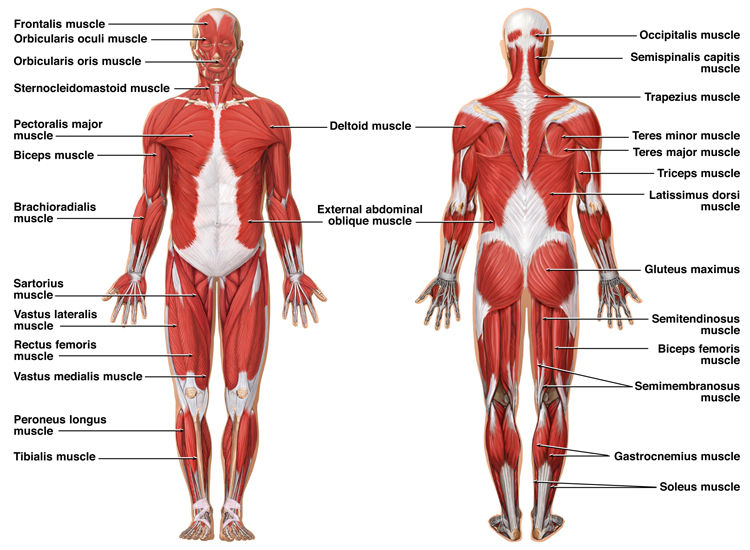
SEMG Monitoring
Clinicians should use a wide bandpass whenever possible, small sensors (12-15 mm), and placement of active sensors parallel to muscle striations.Training Sequence
Rehabilitation proceeds from proximal (trunk) to distal (extremities).Training may start with the anterior deltoid and then move to the middle deltoid, wrist extensors, fingers, and thumb.
This sequence provides a stable platform required for the effective use of extremities like the fingers.Training starts in a supine (on the back) position and then moves to sitting, standing, and walking.
A therapist follows the proximal to distal sequence in each position. The therapist trains the patient to reduce spastic muscle activity at rest and maintain low EMG levels when the muscles are passively stretched or stimulated by vibration. When spastic agonists are relaxed in each position, the same proximal to distal sequence is repeated to strengthen weak antagonists. The final stage of training shapes purposeful movements like walking or grasping a cup.Overview
Click on the Read More button to learn about Wolf's motor copy technique, best treatment candidates, and clinical success predictors.
Motor Copy
Hemiplegia involves paralysis of only half of the body. Wolf (1985) uses a patient's bilateral control (rubrospinal and ventromedial tracts) over skeletal muscles in the motor copy technique.The clinician asks the patient to contract an extensor on the unaffected side and then displays an EMG tracing of this effort. Next, the clinician asks the patient to match this tracing during the contraction of a mirror image extensor on the affected side. When patients successfully copy the healthy movement, they may have substituted bilateral for contralateral (lateral corticospinal tract) control.
Treatment Candidates
The main requirements for biofeedback-assisted rehabilitation are intact motor units that can be recruited and the ability to understand and remember instructions, localize a limb or joint in space, and interact with the therapist or instrument. The availability of intact motor units can be confirmed by inserting percutaneous electrodes in a muscle and instructing the patient to perform voluntary movements. These electrodes may be required because muscle output is weak, the muscle lies deep beneath the skin, adjacent muscles contaminate the EMG signal, or the EMG signal is absorbed by subcutaneous fat.Predictors of Clinical Success
Loss of proprioception, receptive aphasia, and active shoulder range of motion may limit treatment outcome in upper extremity hemiplegic patients. Treatment outcome seems unrelated to age, sex, time since stroke, length of previous treatment, degree of expressive aphasia, or lesion site. For hemiplegics, reduced muscle hyperactivity during passive stretching and the ability to isolate wrist and finger movements may best predict improvement.Biofeedback Modalities
Clinicians routinely monitor EMG activity, force, joint angle, and velocity when treating neuromuscular disorders.EMG biofeedback measures muscle action potentials that precede the mechanical contraction of a muscle.
Force Feedback
Force feedback is the feedback of force conducted through the body or hand during work or exercise or through a lower limb (force plate) or assistive device (feedback cane) to train patients to stand or walk.Listen to a mini-lecture on Force Feedback © BioSource Software LLC.
Three forms of force feedback may supplement EMG biofeedback: a feedback cane, limb load monitor (LLM), and force transducer.
A feedback cane uses a strain gauge to measure the pressure applied to the cane when it is used to assist walking. When the patient uses the cane inappropriately (force exceeds a preset threshold), a warning tone reminds the patient to bear more weight. A therapist can gradually adjust a threshold downward to shape independent ambulation (walking) gradually. The feedback cane also may be used after a hip replacement to increase reliance on the cane to prevent injury initially.
A limb load monitor (LLM) is a force feedback device used to train hemiplegic patients to balance their weight distribution (rising from a chair, sitting, and standing) and to shift weight during the "stance phase" of walking. A force transducer can be inserted in a shoe or placed inside a platform.
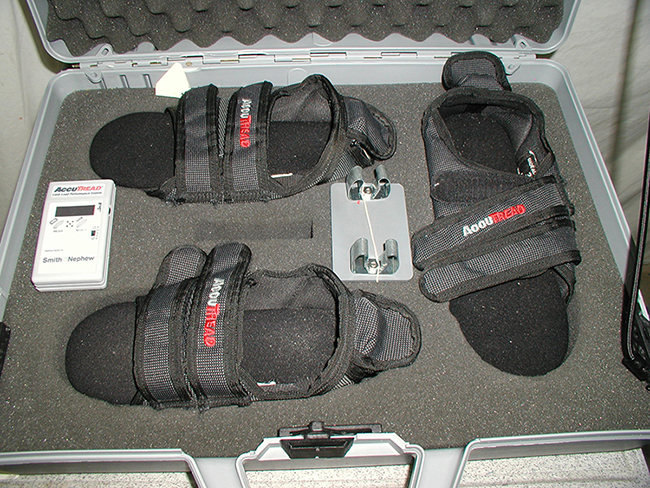

A Cochrane Systematic Review by Barclay-Goddard et al. (2004) examined seven trials with 246 participants. While visual and visual plus auditory force platform feedback improved stance symmetry, they did not improve sway, clinical outcomes, or function.
Wolf (1985) proposed that clinicians use this device diagnostically to record force output to evaluate gait parameters like cadence and velocity. The LLM can be used in physical therapy to provide auditory and visual feedback when the patient meets the therapist's goals for the amount of force and weight distribution during standing and walking. The therapist can adjust the LLM parameters to shape ambulation as with the feedback cane.
A force transducer detects the force conducted through the body or hand during work or exercise. Below is a MindMedia force sensor.
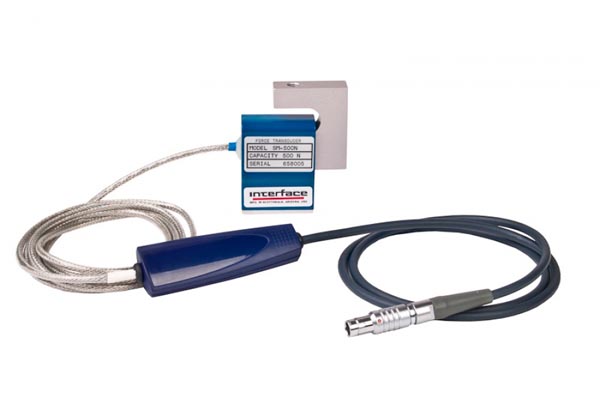
Joint Angle Feedback
Joint angle is observed when we are concerned with the degree of knee extension or wrist pronation.Listen to a mini-lecture on Joint Angle Feedback © BioSource Software LLC.
This modality is measured by electrogoniometers which reflect the change in joint angle by changing resistance to current. Finally, velocity feedback monitors variation in the movement of a body part. Symptoms, like hand tremor, can be measured by an accelerometer.
EMG biofeedback is not always the modality of choice.
Muscles that control patient performance cannot always be monitored by surface or percutaneous electrodes. Further, the most direct performance index may be force, joint angle, or velocity instead of EMG level. Clinicians should use the biofeedback modality that most directly and immediately measures the treated symptom.
The best biofeedback modality can amplify the effectiveness of physical therapy by providing specific information in real-time. Biofeedback measurements can assist the clinician during diagnosis, physical therapy exercises, and evaluation of patient improvement, supplementing less precise and immediate data from observation and palpation. Examples are electrogoniometers, velocity feedback sensors, Real-Time Ultrasound Imaging (RTUS), and camera-based systems.
Real-Time Ultrasound Imaging (RTUS)
An electrogoniometer is a potentiometer that translates a change in joint angle into a change in electrical resistance.
An electrogoniometer provides feedback for changes in joint angle.
A threshold can be selected to adjust joint position feedback. For example, excessive forearm extension can trigger a tone that is silenced when the joint angle falls below a threshold.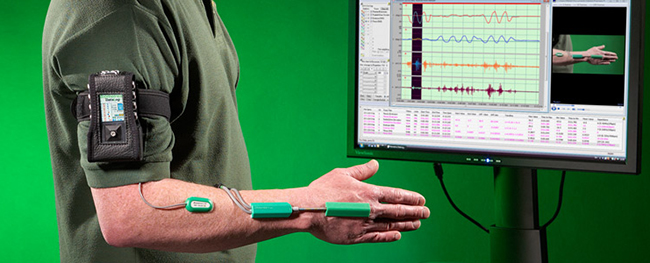
Velocity Feedback
An accelerometer measures the linear motion of a body part, like the wrist. A gyroscope (shown below) measures rotational motion and is not influenced by gravity. These instruments can measure the variation in wrist movement (lap to table surface) and hand tremor. A patient watches the feedback display, instead of the involved hand, to suppress tremors. Velocity feedback is more direct than EMG biofeedback since it monitors the motor behavior we want to modify (tremor). Below are MindMedia and Svantek accelerometers.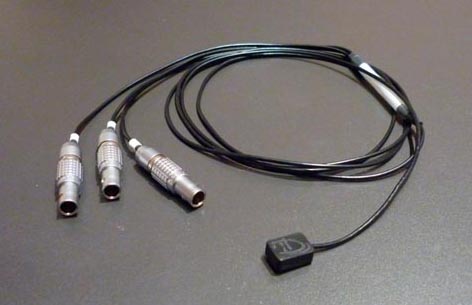
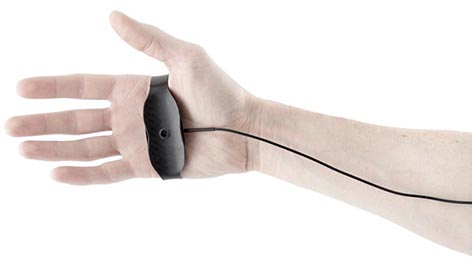
Real-Time Ultrasound Imaging (RTUS) Biofeedback
RTUS transmits ultrasound pulses into the musculature to provide a real-time display of changes in muscle length and shape during clinical instruction. This modality has been used to help patients visualize changes in the abdominal wall and pelvic floor (Giggins et al., 2013).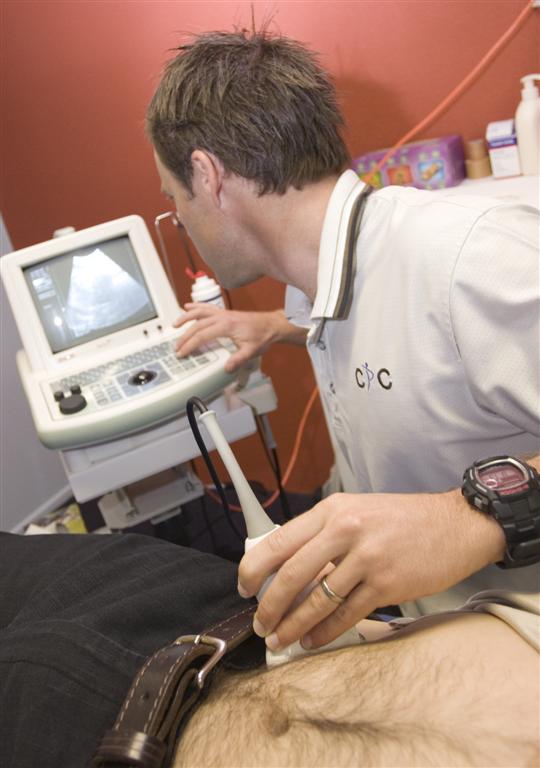
Camera-Based Systems
Video cameras can provide qualitative feedback regarding their performance of an exercise. Video feedback can supplement a clinician's verbal description of their posture and movement, aiding their skill acquisition.
A network of cameras coupled with markers placed on a patient's body can provide quantitative 3-D analysis of dysfunctional movement. In sport psychology, this technology is used to help evaluate and improve an elite athlete's performance.
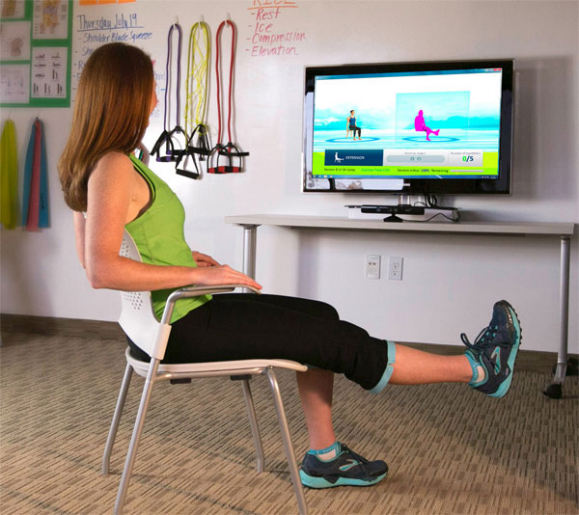
Stroke Outcomes
Treatment outcomes are better for the lower than upper extremities.
Wolf (1982) reported 20% of stroke patients regained independent use of the upper extremity, 30-40% improved, and 30-40% did not improve. In contrast, 60% of Wolf's sample could walk independently, 30% required fewer assistive devices (walkers), and 10% did not improve.Why the dramatic difference in outcome? Thirty-four different muscles control the hand. The motor regions that control any of these muscles can be devastated by a stroke. In particular, the movement of our upper extremities requires thumb movement. Unfortunately, the cortical area that controls the thumb is a large target that a stroke is likely to damage. Surface EMG recording is prevented by the thenar eminence's (thumb) small surface area, and there are no good substitutions systems.
Recovery Variables
Reduced spasticity and relationship with the patient may be important variables in patient recovery. Wolf (1982) believes that reduced agonist spasticity accounts for most improvement in neuromuscular rehabilitation. This makes sense since the antagonist opposes the agonist at a joint. Regular movements like an extension (by the triceps) are prevented if the agonist (biceps) is spastic.Wolf (1985) suggests that the therapist's relationship with the patient may also influence recovery. Patients may be more strongly motivated to participate in rehabilitation exercises when they perceive that the therapist is competent and cares about them.
Gait Training
Foot drop is typical in hemiplegia due to stroke. This disorder involves failure to dorsiflex and evert the foot.
The cause is weakness or paralysis of dorsiflexor (tibialis anterior) and evertor (extensor digitorum longus) muscles of the foot and toes combined with spasticity in the plantar flexors (gastrocnemius). Tibialis anterior (left) and gastrocnemius (right) graphics © CLIPAREA | Custom media/Shutterstock.com.
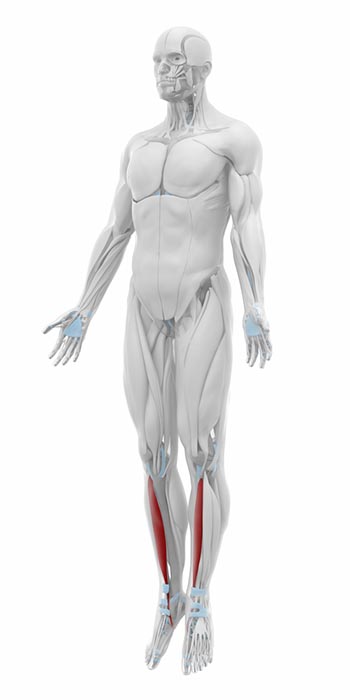 |
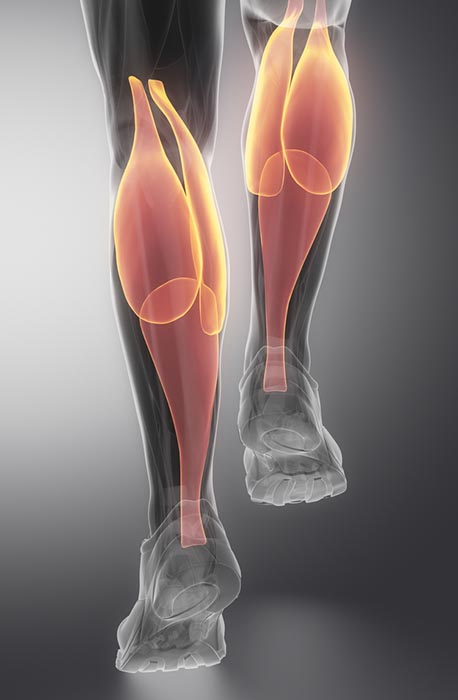 |
EMG-assisted rehabilitation attempts to strengthen dorsiflexors and evertors while reducing spasticity in opposing plantar flexors.

Biofeedback Studies
Meta-analytical studies have found conflicting results for EMG biofeedback in the treatment of stroke patients. EMG biofeedback has been shown to improve lower extremity function. Click on the Read More button to review these studies.Schleenbaker and Mainous (1993) analyzed eight studies that involved 192 patients and found that EMG biofeedback was helpful in treating hemiplegic stroke patients. The effect size was an impressive 0.81.
Moreland, Thomson, and Fuoco (1998) concluded that EMG biofeedback produced greater ankle dorsiflexor strength than physical therapy but failed to improve ankle range of motion or angle during gait, gait quality or speed, or stride length.
EMG biofeedback is not consistently effective for improving upper extremity function or range of motion.
Inglis et al. (1984) reported that EMG biofeedback contributed to upper limb performance in hemiparetic upper limbs when added to physiotherapy in a long-term crossover study.
However, Moreland and Thomson (1994) found that EMG biofeedback and physical therapy produced equivalent changes in upper extremity function.
Glanz et al. (1995) analyzed eight studies and found no evidence that EMG biofeedback could restore hemiparetic upper or lower extremity joints' range of motion. A Cochrane Systematic Review (Woodford & Price, 2006) of 13 studies that examined 269 patients concluded that biofeedback did not significantly improve the outcome of standard physiotherapy.
A Cochrane Systematic Review (Pollock et al., 2014) of 503 studies that involved 18,078 participants concluded that high-quality evidence was needed to validate and compare routine interventions to improve upper limb function following stroke. The authors found moderate-quality evidence supporting the efficacy of constraint-induced movement therapy (CIMT).
Neurofeedback Studies
Cannon, Sherlin, and Lyle (2010) reported treating a 43-year-old female patient diagnosed with a right hemisphere stroke. Fifty-two sessions of NF over six months successfully reduced theta power in the left parietal and central sites and increased beta power in the occipital lobe. QEEG changes were associated with improved self-reported cognitive performance, manual dexterity, and mood.Clinical Efficacy
Based on 18 RCTs, Moss (2023) rated EMG biofeedback for stroke as level 4 - efficacious in Evidence-Based Practice in Biofeedback and Neurofeedback (4th ed.). Several RCTs demonstrated functional improvements in joint angle and gait. These studies compared SEMG biofeedback-assisted PT with PT and sham feedback training. In most studies, SEMG biofeedback training contributed to functional improvement when added to standard care.SPINAL CORD INJURY
When trauma severs the spinal cord, muscle groups below the site of injury may be disconnected. No motor commands can reach them, and they cannot send proprioceptive information back to the brain. Rehabilitation can be attempted only when a spinal cord lesion is incomplete, and there are intact pools of motor units that can be recruited through exercise. Graphic © Lightspring/Shutterstock.com.
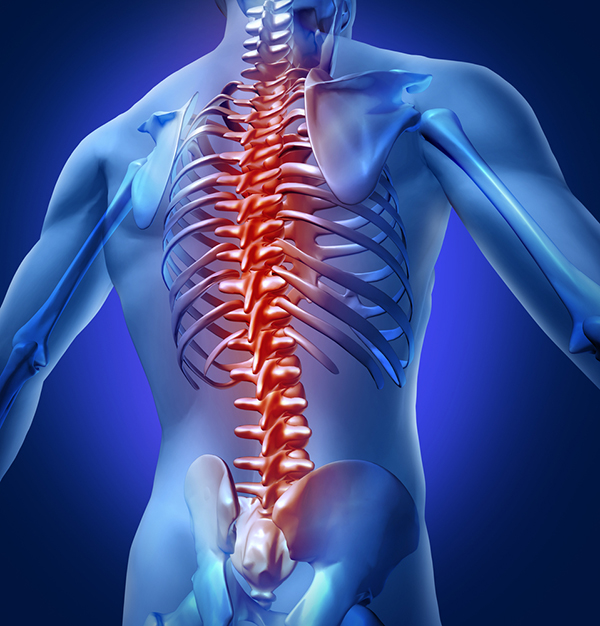
Demographics
Approximately 232,000-316,000 people in the United States may be diagnosed with spinal cord injury. Based on data from the 1990s, there are about 12,000 new patients per year. Since 2005, the most frequent causes have been motor vehicle accidents (40.4%), falls (27.9%), and violence (15%), mainly using firearms (Chin, 2014).EMG Biofeedback
Fortunately, almost all spinal cord injuries are incomplete, and the remaining motor neuron cell bodies can be trained. Marked flexor spasticity is seen 3-6 months after spinal cord injury. Without treatment, this can result in muscle shortening (contracture). Extensor spasticity starts about 6 months following spinal cord injury. A clinician can use percutaneous EMG evaluation in acute (recent) cases to identify muscle groups that are still connected and can benefit from isometric strengthening.EMG biofeedback-assisted rehabilitation is promising for both quadriparetic patients (weakness in four limbs) and paraparetic patients (weakness in lower limbs). The hemiplegia treatment protocol described earlier is also used in incomplete spinal cord lesions. The main clinical objective is to reduce the spasticity of agonists in response to passive stretching (stretching produced by the therapist). As with hemiplegics, a clinician trains affected muscle groups from proximal to distal in supine, sitting, and standing positions. Next, this training sequence is repeated during functional movements like placing clothes in a dryer. Force feedback using the biofeedback cane and limb load monitor may supplement EMG biofeedback.
Biofeedback Studies
Brucker and Bulaeva (1996) reported increasing triceps EMG activity following only one EMG biofeedback training session, with further gains over subsequent sessions.Petrofsky (2001) reported on the success of a 2-month program involving daily training to increase muscle strength and improve gait. Five patients received 30 minutes of EMG biofeedback a day, while the remaining five patients received continuous EMG biofeedback from a portable electromyograph whenever they walked. At the end of 2 months, patients receiving only 30 minutes of biofeedback reduced hip drop by 50%, and those who received continuous feedback achieved near-normal gait.
Clinical Efficacy
Evidence-Based Practice in Biofeedback and Neurofeedback (4th ed.) did not rate EMG biofeedback for incomplete spinal cord lesion.CEREBRAL PALSY
Cerebral palsy (CP) is a family of motor disorders that involve irreversible motor disability due to damage before or soon after birth.
Listen to a mini-lecture on Cerebral Palsy © BioSource Software LLC.
These patients show flaccid paralysis (loss of muscle tone, loss or reduction of tendon reflexes, atrophy, and muscle degeneration), spastic paralysis (increased muscle tone, increased tendon reflexes, and pathological reflexes), and athetoid movements (slow, continuous twisting movements).
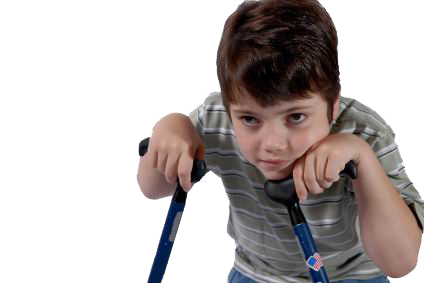
The neurological deficits resemble a stroke. Unlike stroke, lower limb spasticity may be greater, and the antagonist may not be weak but maybe overpowered by a hypertrophied (enlarged) agonist.
Demographics
The prevalence of CP in the United States is 1.5-2 cases in 1000 live births, about 10,000 cases per year. While the initial injury occurs between birth and age 2, diagnosis is usually made after age 1 following failure to meet developmental milestones (Thorogood & Alexander, 2005).Overview
The next sections review the causes, types, symptoms, and medical treatment of cerebral palsy.
Causes of Cerebral Palsy
More than half of the cases are due to prenatal insults that include infection from the mother to the fetus, maternal stroke, environmental toxins, and problems in brain development. The remaining cases are due to adverse events, including traumatic birth delivery, complications of premature birth, meningitis, and head injury during child abuse.Types of Cerebral Palsy
The three main types of cerebral palsy are spastic, dyskinetic, and ataxic. The mixed type combines these symptoms.Symptoms of Cerebral Palsy
About 70-80% of CP patients experience spasticity or limited movement due to permanently contracted muscles. Spasticity is produced by damage to voluntary motor control pathways.About 10-15% of CP patients present with dyskinetic symptoms. These include uncontrolled athetoid movements (slow, continuous twisting movements). Athetoid movements are produced by damage to neurons that inhibit muscle contraction.
Less than 5% of CP patients present with the ataxic type of cerebral palsy. Their coordination is impaired while walking and moving their arms. Ataxia is produced by injury to the cerebellum, which maintains balance and smooths motor performance. Children have decreased muscle tone in hypotonic cerebral palsy. Reduced tone results in muscle weakness and joint instability.
The spastic type of CP is subdivided into hemiplegia (20-30%), which involves the arm and leg on one side, diplegia (30-40%), which involves both lower extremities more often than the upper extremities, and quadriplegia (10-15%), which involves all four limbs and the trunk. Monoplegia, which involves an arm or leg, is rare (Thorogood & Alexander, 2005).
Mental retardation is present in 30-50% of cases (Abdel-Hamid, 2013). Patients with cerebral palsy may also experience epilepsy, visual disturbance, hearing impairment, language difficulty, and slow growth.
Medical Treatment
Physical therapy is used to improve strength, range of motion, and joint mobility. Braces are often used to keep joints in appropriate positions.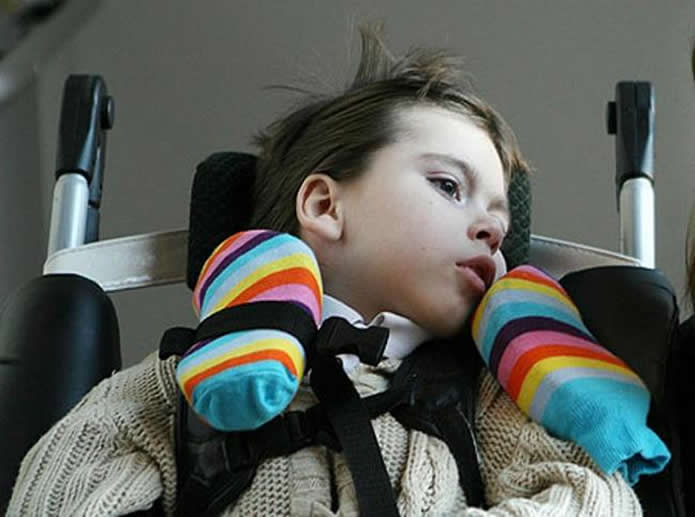
Robotic gait therapy may be used to improve walking. Graphic © Olesia Bilkei/Shutterstock.com.

Medications like Botox are used to treat symptoms like muscle spasticity temporarily.
Rationale for Biofeedback
Cerebral palsy patients often lack normal afferent (incoming sensory) information about limb position and movement. Biofeedback can complement physical therapy for spasticity, athetoid movements, and ataxia by replacing incomplete information from afferent nerves with auditory and visual displays.Biofeedback Studies
Treatment may be designed to correct posture and gait and prevent athetoid movements. SEMG biofeedback may be integrated with rehabilitation exercises to address these problems.Positional feedback may be invaluable in correcting abnormal head position. A feedback helmet with position sensors may sound a warning tone when a patient's head deviates from a normal posture. This device provides more direct and effective feedback than SEMG sensors placed over the sternocleidomastoid or semispinalis capitis muscles that move the head.
Click on the Read More button to review research findings.

Colbourne, Wright, and Naumann (1994) reported that SEMG biofeedback for the triceps surae (leg) increased gait symmetry more than physical therapy.
Toner, Cook, and Elder (1998) reported that SEMG biofeedback to increase the recruitment of ankle dorsiflexors improved tapping, which was used to assess ankle performance.
Bolek, Moeller-Mansour, and Sabet (2001) described a "minimax" procedure that utilizes SEMG biofeedback to teach disabled children how to correctly recruit and relax the gluteus medius and gluteus maximus muscles during sitting. This protocol immediately reinforces correct posture to teach children awareness of good sitting form.
Bolek (2003) reported successful real-time SEMG biofeedback training to recruit and relax the anterior tibialis at the correct points of the gait cycle. He trained two children diagnosed with CP to walk with increased toe clearance during the swing phase of gait.
Bolek (2006) treated 16 children using customized training of multiple SEMG sites and reported improved motor control while sitting or standing, using the upper extremities, and maintaining normal head position.
Dursun, Dursun, and Alican (2004) found that combining EMG biofeedback with conventional exercise produced more significant improvement in plantar flexor muscle tonus and ankle joint range of motion than exercise alone. While gait improved in both groups, the gains were greater for the group that received both EMG biofeedback and exercise.
Bloom, Przekop, and Sanger (2010) reported that EMG biofeedback improved upper extremity function in 10 children diagnosed with cerebral palsy who received training 5 hours per day for 1 month.
Clinical Efficacy
Based on five RCTs and a cross-over design, Donald Moss and Matthew Watkins (2023) rated SEMG biofeedback for cerebral palsy as level 4 - efficacious in Evidence-Based Practice in Biofeedback and Neurofeedback (4th ed.). In particular, Macintosh et al. (2019) reported that 79% of their reviewed studies found improved motor function, and 63% showed gains across the International Classification of Function (ICF) domains.MULTIPLE SCLEROSIS
Multiple sclerosis (MS) involves the progressive destruction of the myelin sheaths that insulate axons, short-circuiting conduction due to an inflammatory process. Myelin lesions desynchronize signal transmission within these networks and disrupt sensory and motor performance (Breedlove & Watson, 2020). Graphics © BlueRingMedia/Shutterstock.com and Wikimedia Commons.
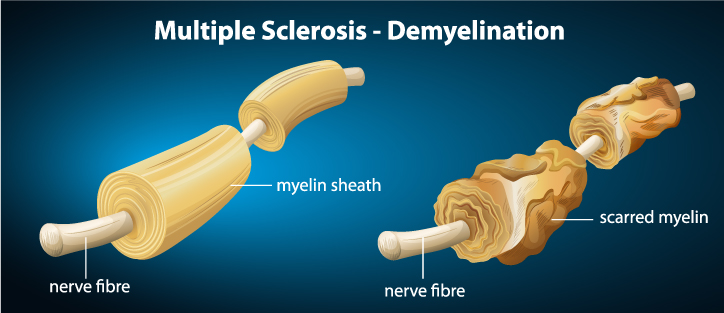
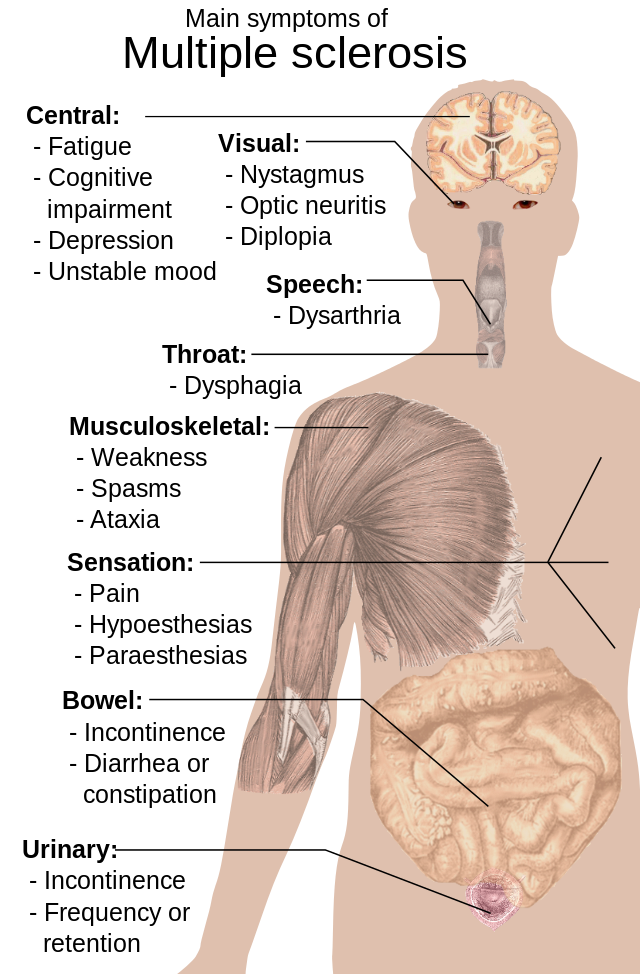
Demographics
There are approximately 400,000 cases of MS in the United States. This disorder is frequently misdiagnosed. MS is more fcommonly seen in women than men (2.3 to 1). While women experience more relapses, men more often experience the primary progressive form. MS is typically diagnosed in individuals 15-45 years but can occur at any age (Luzzio, 2014).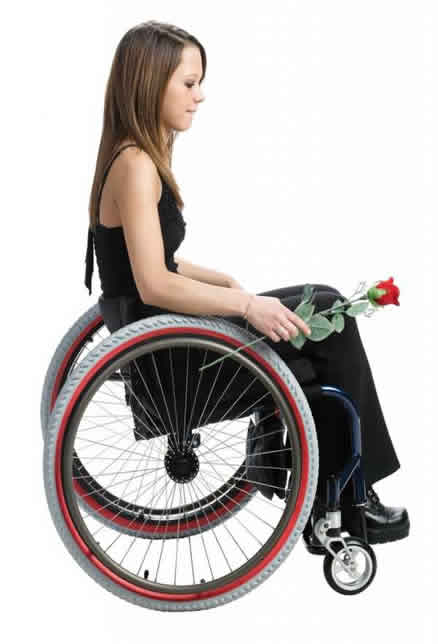
Biofeedback Protocols
Both SEMG-assisted rehabilitation and velocity feedback may be used to correct intention tremors (quivering that appears or worsens when a patient attempts coordinated movement). The SEMG treatment protocol teaches patients to down-train involved muscles and moves from proximal to distal. This approach is time-consuming and suffers from the lack of standardized muscle relaxation criteria.PERIPHERAL NERVE INJURY
Peripheral nerves include the lower motor neurons that innervate skeletal muscles. These may be damaged by trauma, edema (swelling), and infection. Clinical signs of peripheral nerve injury include flaccid paralysis and muscle atrophy (wasting). Examples include Bell's palsy (also called Bell palsy), brachial plexus injuries, and poliomyelitis. Graphic © Blamb/Shutterstock.com.
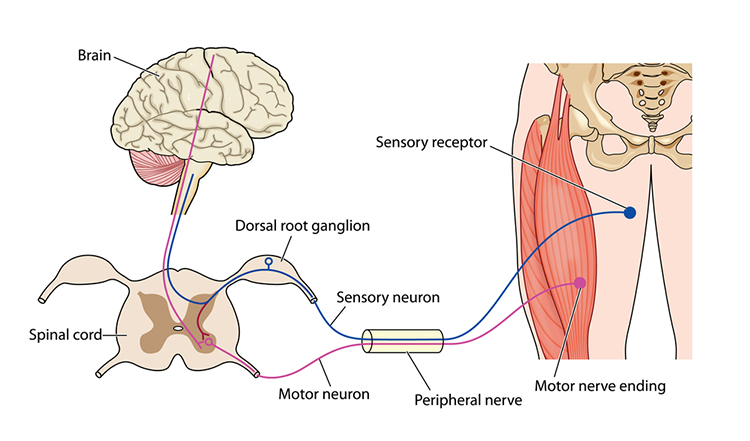
Demographics
Bell's palsy is responsible for about 60-75% of cases of acute unilateral facial paralysis.Listen to a mini-lecture on Bell's Palsy © BioSource Software LLC.
The annual incidence of Bell's Palsy in the United States is 23 per 100,000 cases. This disorder affects the right side of the face in 63% of patients. While Bell palsy generally affects both sexes equally, women 10-19 are at greater risk than men. Pregnant women have a 3.3 times greater risk than nonpregnant women. The lowest incidence of Bell's palsy is under 10, and the highest incidence is 60 and older.

Prognosis for Bell's palsy patients is usually good. About 80-90% of patients recover within 6 weeks to 3 months without visible disfigurement. About 40% of patients 60 years or older completely recover. They have a greater risk of complications like synkinesis (involuntary contraction when another muscle is contracted) and crocodile tears syndrome (profuse tear production when tasting strongly-flavored food), and rare hemifacial spasm (Taylor, 2014).
Biofeedback Protocols
SEMG-assisted rehabilitation has been widely used in Bell's palsy. These patients experience paralysis on one side of the face. The affected half of the face is weak, control over lacrimation (crying) and salivation is lost, and facial expression is abnormal. Possible causes include inflammation, ischemia, and nerve compression of the facial (seventh cranial) nerve. Graphics © Kateryna Kona/Shutterstock.com.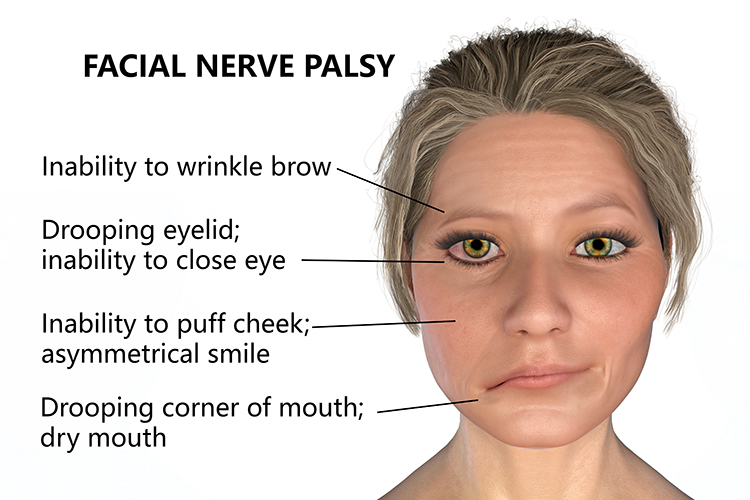
This partial paralysis often remits in several months. The treatment goal is to restore muscle strength and facial symmetry. Muscle strength restoration is only possible if the paralysis remits.
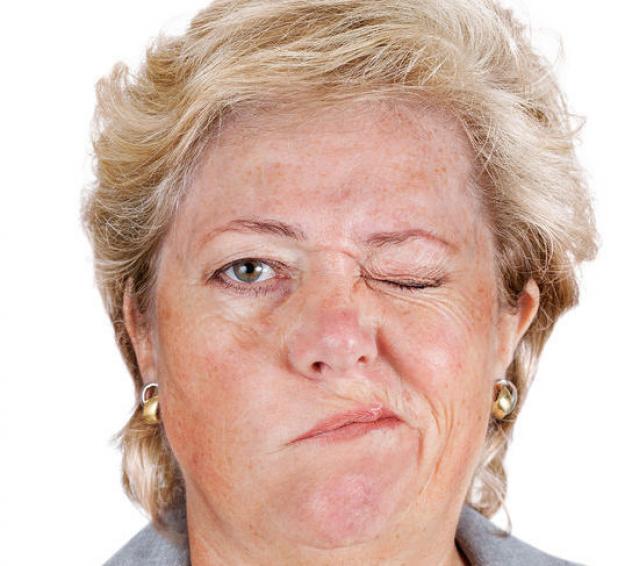

Bell's palsy seems ideally suited for Wolf's (1985) motor copy procedure. The clinician can show the patient a SEMG tracing of a muscle group (orbicularis oculus) on the healthy side of the face and then ask the patient to duplicate it using the corresponding muscle group on the affected side. The healthy muscle group provides a template to correct facial muscle tone.
The orbicularis oculi muscles, which surround the eyes, are shown below.
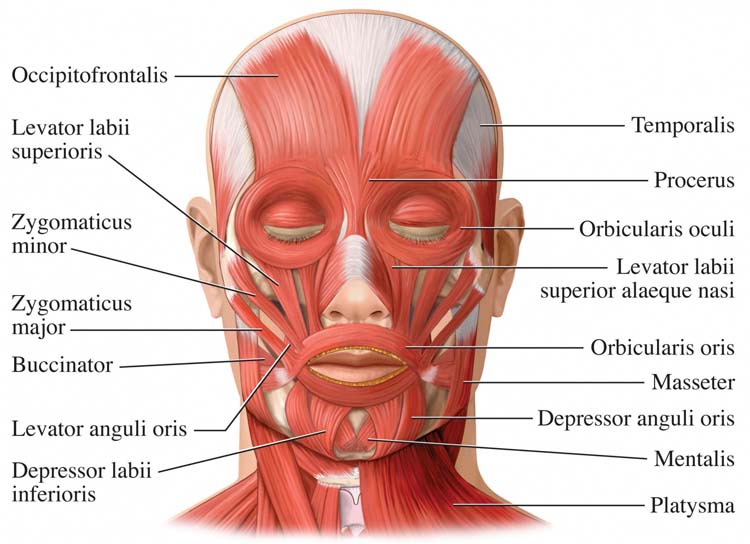
TORTICOLLIS
Torticollis is a form of cervical dystonia characterized by a twisted neck and involuntary neck muscle contraction that results in abnormal head movements and postures.
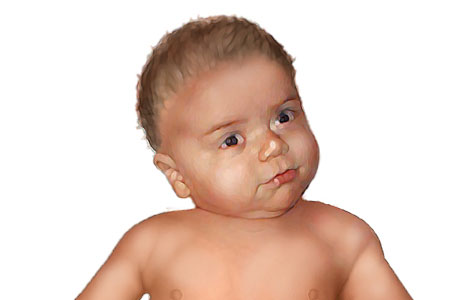
Torticollis symptoms include head-turning (80%), neck pain (50%), head shaking (50%), and abnormal posture (25%). Torticollis has multiple causes. It is divided into two major categories: idiopathic torticollis (80-90%) and acquired torticollis (10-20%).
Idiopathic spasmodic torticollis (IST) is a neurodegenerative disease that destroys dopaminergic neurons in basal ganglia circuits, disinhibiting projections from the thalamus to the cortex and produces postural dystonia.
Listen to a mini-lecture on Torticollis © BioSource Software LLC.
Demographics
From 80-90% of torticollis cases are idiopathic, and the remainder is due to trauma. Women are diagnosed twice as frequently as men. The onset of idiopathic cervical dystonia ranges from 30-50 years (mean 40 years). The incidence of congenital muscular torticollis is 0.4% in newborns (Kruer, 2014).Anatomy and Physiology
Torticollis patients typically deviate the head to one side with slight neck flexion. Severe muscle contraction and spasm may be observed in the following muscles: sternocleidomastoid, levator scapulae, splenius capitis, and trapezius.The sternocleidomastoid muscles have their origin in the sternum and clavicle and insertion in the mastoid process of the temporal bone. Acting together, they flex the cervical vertebral column and extend the head. Working individually, they laterally flex and rotate the head to the opposite side.
Contraction of the left sternocleidomastoid rotates the head to the right.
Graphic © Sebastian Kaulitzki/Shutterstock.com.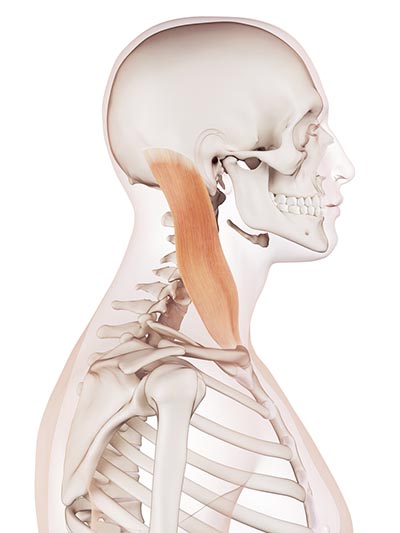

The levator scapulae muscle is located in the posterior neck and lies below the sternocleidomastoid and trapezius muscles. Its origin lies in the cervical vertebrae and insertion in the superior border of the scapula. The levator scapulae elevates the scapula and produces downward rotation.
The splenius capitis muscles (also called cervical muscles) originate in cervical and thoracic vertebrae and insert into the occipital bone and mastoid process of the temporal bone. Acting together, they extend the head. Acting individually, they laterally flex and rotate the head to the same side as the contracting muscle
The trapezius, the most superficial back muscle, is a triangular muscle sheet covering the posterior neck and superior trunk. The two trapezius muscles form a trapezoid. The upper trapezius elevates the scapula and helps extend the head (Tortora & Derrickson, 2021).
Biofeedback Protocols
Following medical evaluation, bilateral SEMG biofeedback can be provided within the context of physical therapy. The therapist should first determine which muscle groups are involved using bilateral SEMG assessment and then train the affected muscle groups.For example, in spasmodic torticollis where a client's head is rotated to the left, a clinician may down-train both the right sternocleidomastoid and left cervical (splenius capitis) muscles. Recall that sternocleidomastoid contraction turns the head to the opposite side and cervical contraction turns the head to the same side as the contracting muscle.

Each muscle group should be trained bilaterally, one at a time. Where there is significant asymmetry, the therapist should gradually down-train the overactive muscle and up-train its weak counterpart. Where spasticity is present, training should gradually reduce SEMG levels and then teach the patient to inhibit spasms during passive stretching and functional activity.
Cleeland's (1989) protocol uses four channels of SEMG to monitor the left and right sternocleidomastoid and trapezius groups. Cleeland reported a treatment protocol where patients receive two daily 45-minutes (Monday-Friday) for 2-3 weeks. After SEMG training allows a patient to return the head to the midline, a spasm is seen. A 3 to 5 mA shock (unpleasant but not painful) is delivered to the first two fingers of either hand when a spasm is detected. This punishment often reduces the spasm.
The therapist emphasizes the patient's active contribution to spasm reduction and motivates them to continue to work learning spasm control. After a patient shows spasm reduction (usually after 4-6 sessions), the patient is instructed to perform spasm reduction exercises in front of a mirror twice a day for 15 minutes each session. To increase control of spasm, once a patient has gained significant head control, they will be monitored with a portable SEMG device while walking and assigned hand-eye coordination tasks like reading or sewing.
After training, patients are treated on an outpatient basis on the following schedule: 2 sessions per day/2 days a week for the first month and 2 sessions per day/1 day a week for the second and third months.
Results for 52 patients who received combined SEMG biofeedback and contingent cutaneous shock showed that at 30.5-month follow-up:
- Minimal or no improvement - 11
- Moderate improvement - 18
- Marked improvement - 8
- Lost to follow-up - 15
The authors reported comparable SEMG reductions in both groups from pre- to post-treatment, feedback-specific neck muscle reduction in the SEMG biofeedback group, similar improvements in head deviation and head range of motion, and that no patient was asymptomatic.
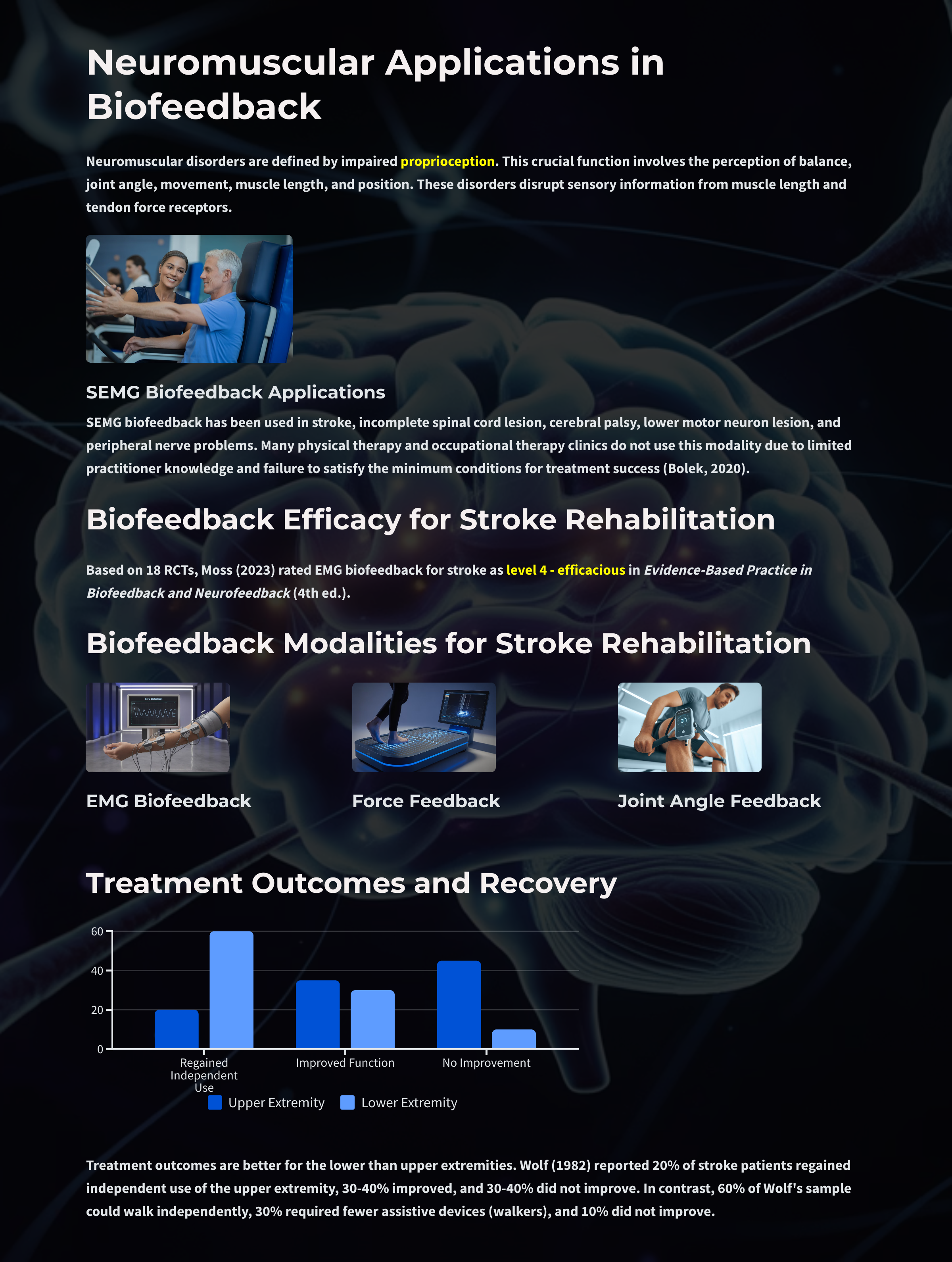
Glossary
accelerometer: a device that measures the linear motion of a body part, like the wrist. Clinicians use this device to monitor variation in wrist movement (lap to table surface) and hand tremors in neuromuscular rehabilitation.
agonist spasticity: excessive muscle tone and tendon reflexes in an agonist muscle observed in hemiplegic patients.
aneurysm: the formation of a blood-filled sac in blood vessel walls due to their dilation or weakening. An aneurysm can produce cerebral hemorrhage.
antagonist paresis: weakness of an antagonist muscle observed in hemiplegic patients.
apoptosis: cell death that can result from glutamate release following cerebral ischemia.
apraxia: the inability to organize movements into a productive sequence, initiate, and perform voluntary skilled movements in the absence of paralysis. These symptoms can result from damage to the left parietal and prefrontal cortex.
arteriosclerosis: the thickening of artery walls and reduction of elasticity.
ataxia: the impairment of the direction, amplitude, and speed of muscular movement. Ataxia is often due to cerebellar damage. Clinicians observe ataxia in a subtype of cerebral palsy (CP) patients whose coordination is impaired while walking and moving their arms.
athetoid movements: slow, continuous twisting movements. These movements are observed in a subtype of cerebral palsy (CP) patients with dyskinetic movements.
Bell's palsy: unilateral facial paralysis caused by disease or trauma to the facial (VII) nerve.
central pattern generators: spinal circuits activated by the lateral and ventral tracts that direct the recruitment of motor units to perform repetitive movements.
cerebral hemorrhage: a subtype of intracranial hemorrhage caused by a cerebral blood vessel's rupture due to hemorrhagic stroke or trauma that releases blood, damaging adjacent neural tissue.
cerebral ischemia: the localized reduction of blood flow to all or part of the brain below the level required to meet metabolic demands that can produce loss of consciousness and irreversible brain damage. The three leading causes are arteriosclerosis, thrombosis, and embolism.
cerebral palsy (CP): a family of nonprogressive motor disorders that involve irreversible motor disability in which skeletal muscles are poorly controlled or paralyzed due to damage before or soon after birth. CP includes spastic, dyskinetic, ataxic, and mixed types.
cerebrovascular accident (CVA): stroke, destruction of brain tissue (infarction) due to cerebral hemorrhage and cerebral ischemia, affecting blood vessels that supply the brain. CVAs show abrupt onset and involve temporary or permanent neurological symptoms like aphasia, paralysis, or loss of sensation.
constraint-induced movement therapy (CIMT): Taub’s stroke protocol restricts the movement of the unaffected limb to force the patient to rely on the affected one and intensively trains patients to use the more affected limb many hours daily. Biofeedback is used as an adjunctive procedure.
corticospinal tract: the pyramidal motor pathway responsible for discrete control of fingers, hands, arms, trunk, and upper legs. The axons of upper motor neurons descend from the primary motor cortex to the medulla to directly or indirectly synapse with lower motor neurons in the ventral gray matter of the spinal cord.
crocodile tears syndrome: profuse tear production when tasting strongly-flavored food. This syndrome is a complication of Bell palsy.
diplegia: paralysis of symmetrical parts of the body. In cerebral palsy (CP), paralysis affects both legs more often than both arms.
distal: the point most distant from the attached end of a limb. In neuromuscular rehabilitation, training ends with extremities like the fingers or toes.
dorsiflexor: the muscle that points the toes toward the shin (superiorly) through flexion at the ankle joint. The tibialis anterior dorsiflexes and inverts the foot during the swing phase of walking.
embolism: the blockage of a blood vessel by an embolus (air bubbles, blood clots, fat, oil, or tumor cells, or their combination) that travels through the blood. Embolism is a cause of ischemic stroke.
EMG biofeedback: the display of a client’s muscle action potentials, which precede the mechanical contraction of a muscle, back to the individual.
ergonomic assessment: the evaluation of workplace safety, comfort, ease of use, worker capabilities, productivity, and performance to improve safety, efficiency, and satisfaction.
evertor: the muscle that turns the sole of a foot outward. The extensor digitorum longus dorsiflexes, extends toes, and everts the foot.
extensor spasticity: excessive extensor muscle activity that starts about six months following spinal cord injury.
extrapyramidal motor system: the motor pathway that controls bilateral, gross movements and postural changes and arises from neurons in the cerebral cortex, basal ganglia, cerebellum, and reticular formation.
feedback cane: a rehabilitation device that uses a strain gauge to measure pressure applied to the cane when used to assist walking after hip replacement surgery or stroke. When a patient misuses the cane, a warning tone reminds the patient to bear more weight.
feedback helmet: positional biofeedback device that sounds a warning tone when a patient's head deviates from a normal posture. Clinicians use a feedback helmet to teach cerebral palsy (CP) patients to maintain normal head position.
flaccid paralysis: the weakness or loss of muscle tone due to injury or disease affecting lower motor neurons.
flexor spasticity: excessive flexor muscle activity that starts 3-6 months after spinal cord injury.
Flexeril: (cyclobenzaprine): a centrally-acting muscle relaxant.
foot drop: the failure to dorsiflex and evert the foot due to weakness or paralysis of dorsiflexor (tibialis anterior) and evertor (extensor digitorum longus) muscles of the foot and toes combined with spasticity in the plantar flexors (gastrocnemius). Abnormal gait is caused by neurologic (hemiplegia due to stroke), muscular, or structural problems.
force feedback: the display of force conducted through the body or hand during work or exercise, or through a lower limb (force plate) or assistive device (feedback cane) to the client to teach normal position and movement.
force transducer: a sensor that converts the force conducted through the body or hand during work or exercise into electrical signals.
gastrocnemius muscle: the muscle that plantar flexes the foot and flexes the knee joint. Spasticity in this muscle can interfere with detecting weak antagonists like the tibialis anterior.
glutamate: an amino acid and most common excitatory neurotransmitter. Glutamate release after ischemia or trauma may trigger a cascade that results in cell death.
goniometer: an electrical or a mechanical rehabilitation device that monitors joint angle to teach clients to increase their range of motion about a joint. An electrogoniometer represents a change in joint angle by altering its resistance to current.
gyroscope: a device that measures rotational motion and is not influenced by gravity. This device is used to measure the variation in wrist movement (lap to table surface) and hand tremor.
hemiplegia: the paralysis of the upper extremity, trunk, and lower extremity muscles on one side. Stroke can result in agonist spasticity (excessive muscle tone and tendon reflexes) and antagonist paresis (muscle weakness).
hyperreflexia: extreme reactivity and exaggeration of reflexes can lead to spastic paralysis following corticospinal tract damage and spasticity following extrapyramidal system damage.
hypertrophy: excessive muscle enlargement following stroke. An enlarged agonist may overpower antagonist muscles.
hypotonic: decreased muscle tone. Loss of muscle tone causes muscle weakness and joint instability in the ataxic subtype of cerebral palsy.
idiopathic spasmodic torticollis (IST): a neurodegenerative disease that destroys dopaminergic neurons in basal ganglia circuits, which disinhibits projections from the thalamus to the cortex and produces postural dystonia. These patients typically deviate the head to one side with slight neck flexion, and physical therapy may incorporate SEMG biofeedback.
intention tremor: quivering that appears or worsens when a patient attempts coordinated movement. Causes include alcohol intoxication, prescription drugs, and focal lesions that disrupt the cerebellar hemispheres.
intracerebral hemorrhage (ICH): the release of blood into the brain due to brain trauma or hemorrhagic stroke.
joint angle: the angle between the longitudinal axes of two adjoining body parts. Rehabilitation therapists monitor this variable using goniometers to train clients to increase their range of motion (knee extension or wrist pronation).
lateral group: the descending pathway from the primary motor cortex (the corticospinal, corticobulbar, and rubrospinal tracts) that helps execute its motor programs.
limb load monitor (LLM): force feedback device used to train hemiplegic patients to balance their weight distribution (rising from a chair, sitting, and standing) and to shift weight during the “stance phase” of walking. A force transducer can be inserted in a shoe or placed inside a platform.
lower motor neurons: alpha and gamma motoneurons that connect the brainstem and spinal cord to skeletal muscle fibers.
meninx (plural, meninges): protective tissue layer that surrounds the brain and spinal cord.
monoplegia: rare paralysis that involves an arm or leg. Monoplegia is found in the spastic subtype of cerebral palsy.
multiple sclerosis (MS): the progressive and widespread destruction of the myelin sheaths that insulate axons, which short-circuits conduction and produces cognitive, motor, and sensory impairment.
musculoskeletal weakness: the inability to generate normal muscular strength due to diverse causes, including brain tumor, stroke, spinal cord damage, amyotrophic lateral sclerosis, diabetes, Guillain-Barre Syndrome, myasthenia gravis, and Duchenne’s disease.
NMDA receptor: ionotropic glutamate receptor. Their overactivity may mediate ischemic damage to oligodendrocytes.
oligodendrocytes: glial cells that myelinate axons in the CNS.
orbicularis oculi: the facial muscle that closes the eyelids and wrinkles the forehead. Flaccid paralysis of this muscle occurs in Bell palsy, and spasm produces blepharospasm.
paralysis: the loss or impairment of muscle function due to a muscular or nervous system lesion that may also involve sensory deficits.
paresis: muscle weakness or partial paralysis.
percutaneous electrode: an electrode inserted through the skin. For example, an inserted EMG electrode is used to evaluate the viability of motor units in a stroke patient.
peripheral nerve: the nerves of the autonomic, enteric, or somatic nervous system, including the lower motor neurons that innervate skeletal muscles.
plantar flexors: the muscles that point the toes downward (inferiorly) through extension at the ankle joint. For example, the tibialis posterior plantar flexes and inverts the foot.
positional feedback: the display of information about the position of the body or a body part like the head in three-dimensional space to correct balance and posture, for example, a feedback helmet.
prefrontal cortex: the most anterior division of the frontal lobe, composed of dorsolateral, medial, and orbitofrontal divisions, concerned with attention, consciousness, emotion, facial recognition, executive functions like forward-thinking, planning and strategy, and language.
premotor cortex: nonprimary motor cortex anterior to the primary motor cortex that adjusts existing motor programs under the guidance of external sensory information and contains mirror neurons.
primary motor cortex (M1): the proposed executive region, mainly located in the precentral gyrus, for initiating movement through the descending lateral and ventromedial groups.
proprioception: the perception of body movement and position.
proximal: toward where a limb attaches to the trunk. In neuromuscular rehabilitation, the site where training starts.
pyramidal motor system: the corticospinal motor pathway responsible for discrete control of fingers, hands, arms, trunk, and upper legs. The axons of upper motor neurons descend from the primary motor cortex to the medulla to directly or indirectly synapse with lower motor neurons in the ventral gray matter of the spinal cord.
quadriplegia: the paralysis of all four limbs and the trunk. Quadriplegia is found in the spastic subtype of cerebral palsy.
quantitative surface electromyography (QSEMG): monitoring SEMG activity from multiple muscle sites to teach patients new muscle recruitment patterns to achieve functional movements.
shaping: the reinforcement of successive approximations of a target behavior.
spastic paralysis: the loss of muscle function associated with involuntary muscle contraction, increased tendon reflexes, and pathological reflexes.
spasticity: elevated muscle tone with increased resistance to stretch.
splenius capitis (cervical muscles): the muscles retrained in torticollis. Acting together, they extend the head, working individually, they laterally flex and rotate the head to the same side as the contracting muscle.
sternocleidomastoids: the muscles retrained in cerebral palsy and torticollis. They flex the cervical vertebral column and extend the head; working individually, they laterally flex and rotate the head to the opposite side.
stroke: a cerebrovascular accident (CVA), destruction of brain tissue (infarction) due to cerebral hemorrhage and cerebral ischemia, affecting blood vessels that supply the brain. CVAs show abrupt onset and involve temporary or permanent neurological symptoms like aphasia, paralysis, or loss of sensation.
subarachnoid hemorrhage: the release of blood into the subarachnoid space between the protective middle meninx and the brain.
supine: on the back. In neuromuscular rehabilitation, biofeedback training starts in this position and then moves to sitting, standing, and walking.
supplementary motor area (SMA): the nonprimary motor cortical region that receives information from the basal ganglia and programs movements into sequences during learning (pre-SMA) and performing a learned sequence from memory (caudal SMA).
synkinesis: the involuntary contraction when another muscle is intentionally contracted. Synkinesis is a complication of Bell palsy.
thenar eminence: the rounded body of muscle on the palm near the base of the thumb comprised by the abductor pollicis brevis, flexor pollicis brevis, and opponens pollicis.
thrombosis: the formation of a stationary clot (thrombus) within a blood vessel, usually a vein, that obstructs circulation.
thrombus: a stationary clot formed in a blood vessel that is usually a vein.
tibialis anterior: the muscle that dorsiflexes and inverts the foot. In neuromuscular rehabilitation, this muscle is up-trained to treat foot drop.
torticollis: a cervical dystonia characterized by a twisted neck and involuntary neck muscle contraction that results in abnormal head movements and postures. These patients typically deviate the head to one side with slight neck flexion, and physical therapy may incorporate SEMG biofeedback.
transient flaccid paralysis: the complete loss of muscle tone, with paralysis seen immediately after damage to the pyramidal motor system. It usually lasts for only a few days or weeks and is gradually replaced by a more permanent state of hyperreflexia, which may lead to spastic paralysis.
trapezius: the most superficial back muscle is a triangular muscle sheet covering the posterior neck and superior trunk. The upper trapezius elevates the scapula and helps extend the head, and maybe retrained in torticollis.
upper motor neurons: the motor neurons that project from the motor region of the cerebral cortex or brainstem to synapse with spinal interneurons or lower motor neurons.
velocity feedback: the display of the variation in the movement of a body part. An accelerometer can measure symptoms like hand tremors.
ventromedial group: the descending pathway from the primary motor cortex (vestibulospinal, tectospinal, reticulospinal, and ventral corticospinal tracts) that helps execute its motor programs.
Wolf's (1985) Concurrent Assessment of Muscle Activity (CAMA): a rehabilitation protocol in which a clinician uses biofeedback information to suggest changes in ongoing patient posture, position, or movement, and as the patient attempts the recommended change, the clinician can evaluate its effectiveness and provide new instructions. Alternatively, the clinician can directly display information to the patient to modify performance.
Wolf's motor copy procedure: a rehabilitation protocol in which a clinician asks the patient to contract an extensor on the unaffected side and then displays an EMG tracing of this effort. Next, the clinician asks the patient to match this tracing during contraction of a mirror image extensor on the affected side to teach them to substitute bilateral control for contralateral (lateral corticospinal tract) control.
Test Yourself
Click on the ClassMarker logo to take 10-question tests over this unit without an exam password.

REVIEW FLASHCARDS ON QUIZLET
Click on the Quizlet logo to review our chapter flashcards.

Visit the BioSource Software Website
BioSource Software offers Human Physiology, which satisfies BCIA's Human Anatomy and Physiology requirement, and Biofeedback100, which provides extensive multiple-choice testing over BCIA's Biofeedback Blueprint.

Assignment
Now that you have completed this module, locate the muscles discussed above in a muscle atlas.
References
Abdel-Hamid, H. Z. (2013). Cerebral palsy. eMedicine.
Adler, J. (March 8, 2004). The war on strokes. Newsweek, 42-48.
Barclay-Goddard, R. E., Stevenson, T. J., Poluha, W., Mofatt, M., & Taback, S. P. (2004). Force platform feedback for standing balance training after stroke (Review). Cochrane Database of Systematic Reviews, 4. https://dx.doi.org/10.1002%2F14651858.CD004129.pub2
Basmajian, J. V. (Ed.). (1989). Biofeedback: Principles and practice for clinicians. Williams & Wilkins.
Bloom, R., Przekop, A., & Sanger, T. D. (2010). Prolonged electromyogram biofeedback improves upper extremity function in children with cerebral palsy. J Child Neurol, 25(12), 1480-1484. https://doi.org/10.1177/0883073810369704
Bolek, J. E. (2006). Use of multiple-site performance-contingent SEMG reward programming in pediatric rehabilitation: A retrospective review. Applied Psychophysiology and Biofeedback, 31(3), 263-272. https://doi.org/10.1007/s10484-006-9017-3
Bolek, J. E. (2012). Quantitative surface electromyography: Applications in neuromotor rehabilitation. Biofeedback, 40(2), 47-56. http://dx.doi.org/10.5298/1081-5937-40.2.6
Bolek, J. E. (2001), Moeller-Mansour, L., & Sabet, A. (2001). Enhanced proper sitting position using a new sEMG protocol, the "minimax" procedure, with Boolean logic. Applied Psychophysiology and Biofeedback, 26(1), 9-16. https://doi.org/10.1023/A:1009559403410
Bolek, J. E. (2020). QSEMG: Quantitative Surface Electromyography: Origins and applications in physical rehabilitation. Biofeedback, 48(2), 26-31. https://doi.org/10.5298/1081-5937-48.2.01
Bolek, J. E., Rosenthal, R. L., & Sherman, R. A. (2016), Advanced topics in surface electromyography. In M. S. Schwartz and F. Andrasik (Eds.). Biofeedback: A practitioner’s guide (4th ed.). The Guilford Press.
Breedlove, S. M., & Watson, N. V. (2020). Behavioral neuroscience (9th ed.). Sinauer Associates, Inc.
Brucker, B. S., & Bulaeva, N. V. (1996). Biofeedback effect on electromyograph responses in patients with spinal cord injury. Archives of Physical Medical Rehabilitation, 77(2), 133-137. https://doi.org/10.1016/s0003-9993(96)90157-4
Cannon, K. B., Sherlin, L., & Lyle, R. R. (2010). Neurofeedback efficacy in the treatment of a 43-year-old female stroke victim: A case study. Journal of Neurotherapy, 14(2), 107-121. https://doi.org/10.1080/10874201003772155
Chin, L. S. (2014). Spinal cord injuries. eMedicine.
Colbourne, G. R., Wright, F. V., & Naumann, S. (1994). Feedback of triceps surae EMG in gait of children with cerebral palsy: A controlled study. Archives of Physical Medicine Rehabilitation, 75(1), 40-45. PMID: 8291961
Dursun, E., Dursun, N., & Alican, D. (2004). Effects of biofeedback treatment on gait in children with cerebral palsy. Disability and Rehabilitation, 26(2), 116-120. https://doi.org/10.1080/09638280310001629679
Giggins, O. M., McCarthy Persson, U., & Caulfield, B. (2013). Biofeedback in rehabilitation. J Neuroeng Rehabil, 10(60). https://doi.org/10.1186/1743-0003-10-60
Glanz, M., Klawansky, S., Stason, W., Berkey, C., Shah, N., Phan, H., & Chalmers, T. C. (1995). Biofeedback therapy in posttroke rehabilitation: A meta-analysis of the randomized controlled trials. Archives of Physical Medical Rehabilitation, 76(6), 508-515. https://doi.org/10.1016/s0003-9993(95)80503-6
Graziano, M. S. A., & Aflalo, T. N. (2007). Mapping behavioral repertoire onto the cortex. Neuron, 56(2), 239-251. https://doi.org/10.1016/j.neuron.2007.09.013
Hartje, J. (1997) Biofeedback: Specific neuromuscular intervention (Module 4). Wheat Ridge: AAPB.
Huang, H., Wolf, S. L., & He, J. (2006). Recent developments in biofeedback for neuromotor rehabilitation. J Neuroengineering Rehabil, 3, 11. https://doi.org/10.1186/1743-0003-3-11
Inglis, J., Donald, M. W., Monga, T. N., Sproule, M., & Young, M. J. (1984). Electromyographic biofeedback and physical therapy of the hemiplegic upper limb. Arch Phys Med Rehabil, 65(12), 755-759. PMID: 6391417
Jadali, C. (2021). Personal communication regarding current use of CIMT in stroke rehabilitation.
Jannett, T. C., Taub, E., & Groom, E. (2002). Microcomputer-based devices for feedback control of constraint-induced movement therapy in lower extremity stroke rehabilitation. Presentation to the Southeastern Symposium on Systems Theory, Nashville.
Jonsdottir, J., Cattaneo, D., Regola, A., Crippa, A., Recalcati, M., Rabuffetti, M., Ferrarin, M., & Casiraghi, A. (2007). Concepts of motor learning applied to a rehabilitation protocol using biofeedback to improve gait in a chronic stroke patient: An A-B system study with multiple gait analyses. Neurorehabil Neural Repair, 21(2), 190-194. https://doi.org/10.1177/1545968306290823
Jia, X., Koenig, M. A., Zhang, X., Zhang, J., Chen, T., & Chen, Z. (2007). Residual motor signal in long-term human severed peripheral nerves and feasibility of neural signal-controlled artificial limb. J Hand Surg [Am], 32(5), 657-666. https://doi.org/10.1016/j.jhsa.2007.02.021
Knapp, H. D., Taub, E., & Berman, A. J. (1963). Movement in monkeys with deafferented forelimbs. Experimental Neurology, 7, 307-315. https://doi.org/10.1016/0014-4886(63)90077-3
Kruer, M. C. (2014). Torticollis. eMedicine.
Liebeskind, D. S. (2014). Hemorrhagic stroke. eMedicine.
Luft, A. R., & Hanley, D. F. (2006). Stroke recovery--Moving in an EXCITE-ing Direction. JAMA, 296(17), 2141-2143. https://doi.org/10.1001/jama.296.17.2141
Luzzio, C. (2014). Multiple sclerosis. eMedicine.
Moreland, J. D., & Thomson, M. A. (1994). Efficacy of electromyographic biofeedback compared with conventional physical therapy for upper-extremity function in patients following stroke: A research overview and meta-analysis. Physical therapy, 74(6), 534-547. https://doi.org/10.1093/ptj/74.6.534
Moreland, J. D., Thomson, M. A., & Fuoco, A. R. (1998). Electromyographic biofeedback to improve lower extremity function after stroke: A meta-analysis. Archives of Physical Medicine Rehabilitation, 79(2), 134-140. https://doi.org/10.1016/s0003-9993(98)90289-1
Moss, D. (2023). Cerebral vascular accident (stroke). In I. Khazan, F. Shaffer, D. Moss, R. Lyle, & S. Rosenthal (Eds). Evidence-based practice in biofeedback and neurofeedback (4th ed.). Association for Applied Psychophysiology and Biofeedback.
Moss, D., & Watkins, M. (2023). Cerebral palsy. In I. Khazan, F. Shaffer, D. Moss, R. Lyle, & S. Rosenthal (Eds). Evidence-based practice in biofeedback and neurofeedback (4th ed.). Association for Applied Psychophysiology and Biofeedback.
Petrofsky, J. S. (2001). The use of electromyogram biofeedback to reduce trendelenburg gait. European Journal of Applied Physiology, 85(5), 491-495. https://doi.org/10.1007/s004210100466
Pollock, A., Baer, G., Pomeroy, V., & Langhorne, P. (2009). Physiotherapy treatment approaches for the recovery of postural control and lower limb function following stroke. Cochrane Database of Systematic Reviews, 2009(1), CD001920. https://doi.org/10.1002/14651858.CD001920.pub2
Pollock, A., Farmer, S. E., Brady, M. C., Langhorne, P., Mead, G. E., Merholtz, J., & van Wijck, F. (2014). Interventions for improving upper limb function after stroke. Cochrane Database Syst Rev, 11. https://doi.org/10.1002/14651858.CD010820.pub2.
Salter, M. G., & Fern, S. (2005). NMDA receptors are expressed in developing oligodendrocyte processes and mediate injury. Nature, 438(22), 1167-1171. https://doi.org/10.1038/nature04301
Schleenbaker, R. E., & Mainous, A. G. (1993). Electromyographic biofeedback for neuromuscular reeducation in the hemiplegic stroke patient: A meta-analysis. Archives of Physical Medicine Rehabilitation, 74(12), 1301-1304. https://doi.org/10.1016/0003-9993(93)90083-m
Shaffer, F., & Moss, D. (2006). Biofeedback. In Y. Chun-Su, E. J. Bieber, & B. Bauer (Eds.). Textbook of complementary and alternative medicine (2nd ed.). Informa Healthcare.
Taub, E. (1994). Overcoming learned non-use: A new approach to treatment in physical medicine. In J. G. Carlson, A. R. Seifert, & N. Birbaumer (Eds.), Clinical applied psychophysiology (pp. 185-220). Plenum.
Taub, E. (2005). Personal communication to Don Moss regarding CIMT.
Taub, E., Uswatte, G., Elbert, T. (2002). An impending paradigm shift: The melding of basic research in neuroscience and behavioral science to produce new treatments in neurorehabilitation. Nature Reviews Neuroscience, 3, 226-236. PMID: 10659807
Taub, E., Uswatte, G., & Pidikiti, R. (1999). Constraint induced movement therapy: A new family of techniques with broad application to physical rehabilitation - A clinical review. Journal of Rehabilitation Research and Development, 36(3), 237-251. PMID: 10659807
Taylor, D. C. (2014). Bell Palsy. eMedicine.
Toner, L. V., Cook, K., & Elder, G. C. (1998). Improved ankle function in children with cerebral palsy after computer-assisted motor learning. Developmental Medicine and Child Neurology, 40(12), 829-835. https://doi.org/10.1111/j.1469-8749.1998.tb12360.x
Tortora, G. J., & Derrickson, B. H. (2021). Principles of anatomy and physiology (16th ed.). John Wiley & Sons, Inc.
Wilson, J. (2003). Biological foundations of human behavior. Wadsworth/Thompson Learning.
Wolf, S. L. (2011). Experiential biofeedback & adaptive learning using mixed reality for stroke. Forty-second annual meeting of the Association for Applied Psychophysiology and Biofeedback (AAPB), New Orleans.
Wolf, S. L., Winstein, C. J., Miller, J. P., Taub, E., Uswatte, G., Morris, D., Giuliani, C., Light, K. E., Nichols-Larsen, D., & EXCITE Investigators (2006). Effect of constraint-induced movement therapy on upper extremity function 3 to 9 months after stroke. JAMA, 296(17), 2095-2104. https://doi.org/10.1001/jama.296.17.2095
Woodford, H., & Price, C. (2006). EMG biofeedback for the recovery of motor function after stroke. Cochrane Database of Systematic Reviews, (2), CD004585. https://doi.org/10.1002/14651858.cd004585.pub2
Yavuzer, G., Eser, F., Karakus, D., Karaoglan, B., & Stam, H. J. (2006). The effects of balance training on gait late after stroke: A randomized controlled trial. Clin Rehabil, 20(11), 960-969. https://doi.org/10.1177/0269215506070315